Health
50 Best Chest Exercises for 2024

In order to pump up your pecs and build the best chest in the gym, you need targeted chest workouts that stimulate muscle growth in the best way possible. Because the main chest muscles (specifically the pectoralis major, aka pecs) are so huge, and contribute to so many movements, you’ll need more than just a handful of moves to build your chest (and entire upper body) from every angle.
These 50 muscle-building chest exercises will develop your pecs (and the surrounding musculature), spark greater levels of strength, and give you a more imposing physique. While some require equipment (think bench and dumbbells for a chest press), others only require a resistance band (like band-resisted pushups and flyes).
Related: Low Weight + High Reps = More Strength
Best Chest Exercises
1. Barbell Bench Press
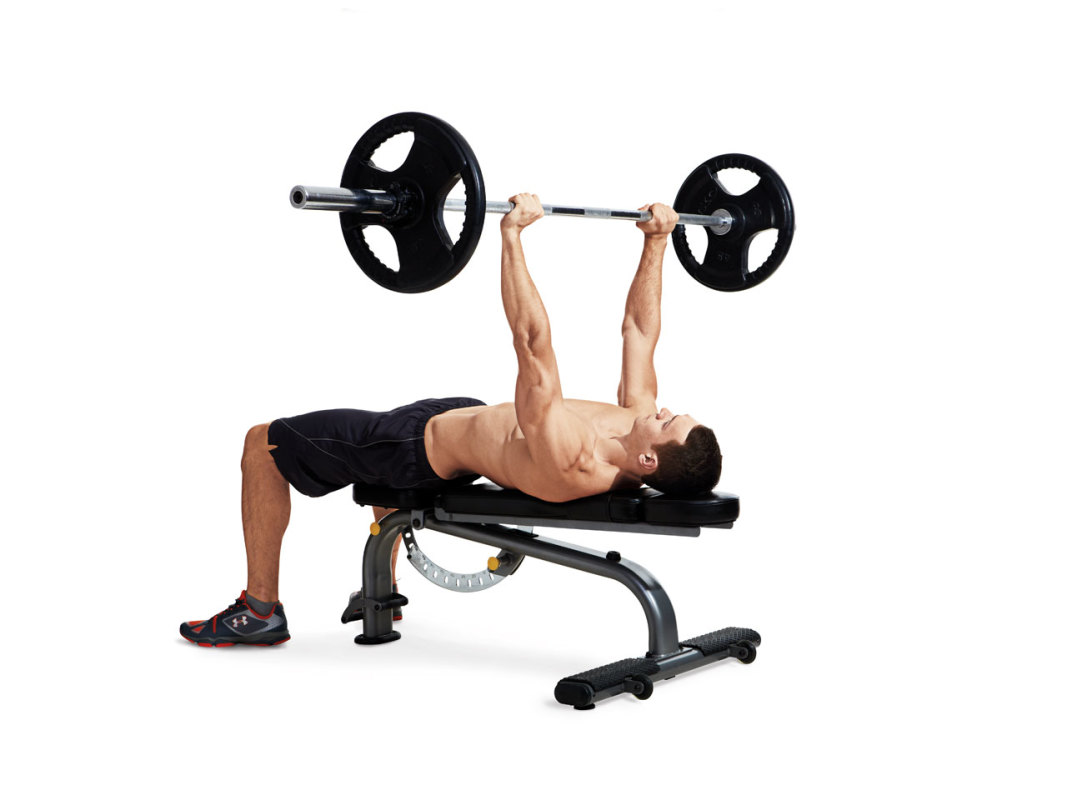
How to do it:
- Grasp the bar just outside shoulder-width and arch your back so there’s space between your lower back and the bench.
- Pull the bar out of the rack and lower it to your sternum, tucking your elbows about 45° to your sides.
- When the bar touches your body, drive your feet hard into the floor and press the bar back up.
2. Dumbbell Bench Press
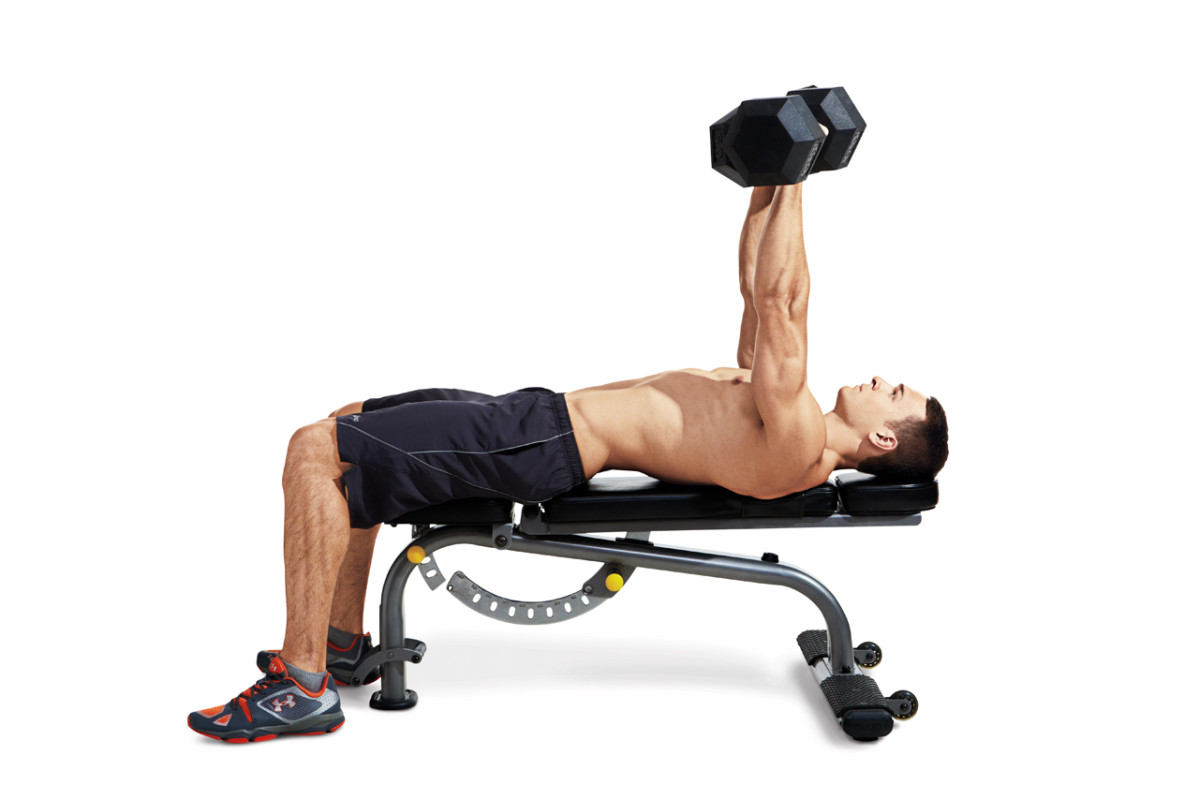
How to do it:
- Lie back on a flat bench with a dumbbell in each hand.
- Hold the weights at shoulder-level
- Then press the weights straight up.
3. Alternating Dumbbell Bench Press
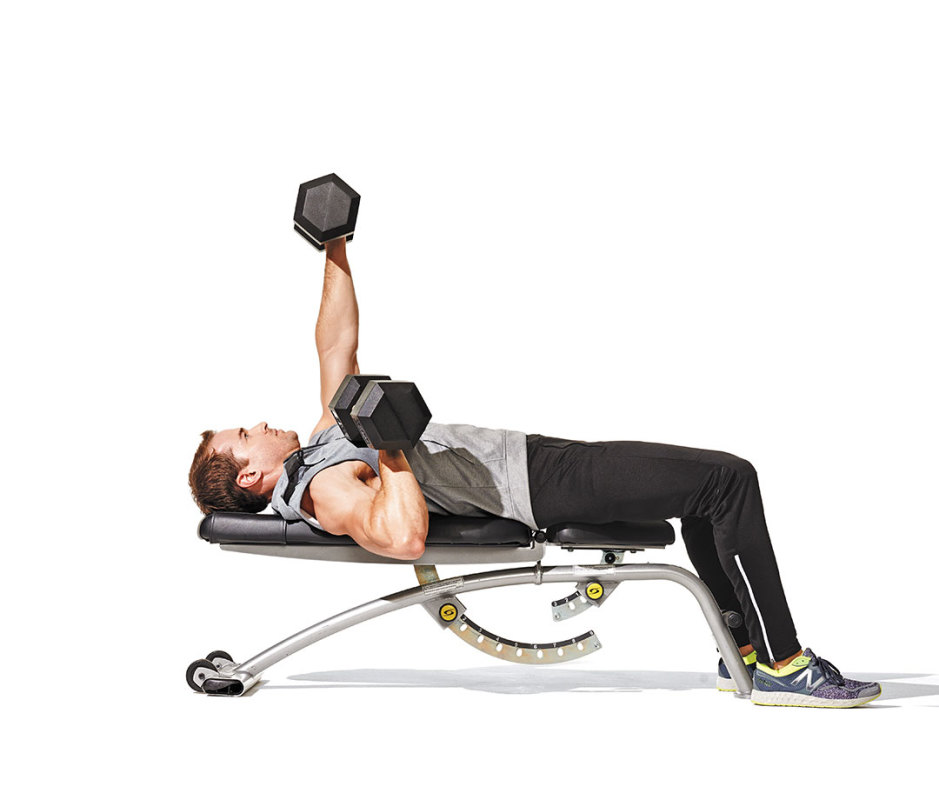
How to do it:
- Lying faceup on a bench, holding dumbbells at the outside of your shoulders and with palms facing your thighs, lift both dumbbells over your chest.
- Keeping one arm straight, lower the other dumbbell, touch the outside of your shoulder, and push it back up. At the top of the movement, push farther with both hands, as if trying to punch the ceiling.
4. Hips-Off, Single-Arm Bench Press
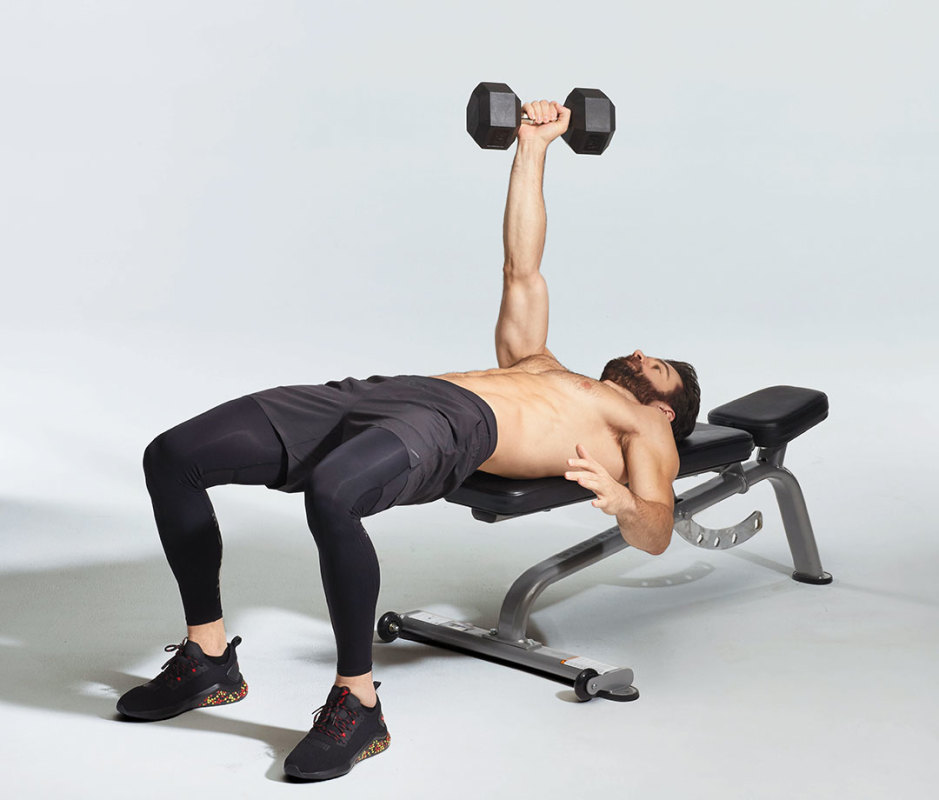
How to do it:
- Lie back on a flat bench so the right half of your torso is off bench, a heavy (40- to 50-pound) dumbbell in right hand.
- Brace core and press dumbbell over right shoulder. Do all reps on right side, then switch sides.
5. Cable Crossover
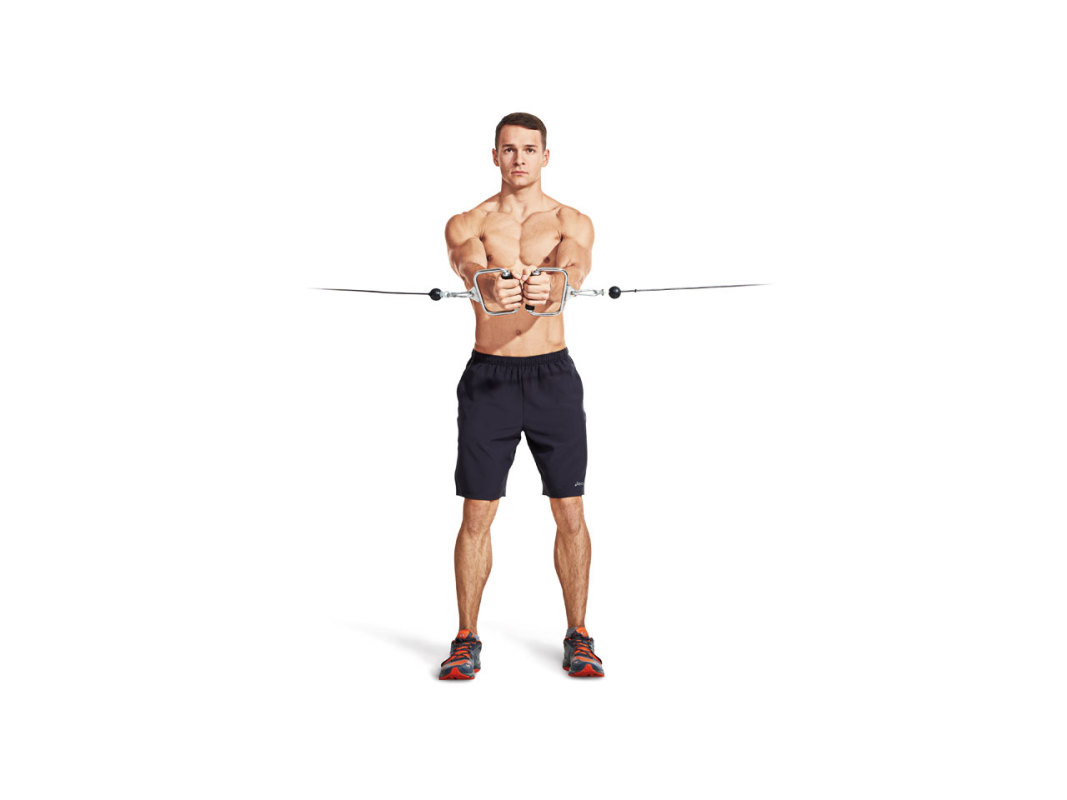
How to do it:
- Stand between two facing cable stations with both pulleys set midway between the top and bottom of the station.
- Attach a D-handle to each pulley and hold one in each hand.
- Keep your elbows slightly bent, and step forward so there’s tension on the cables.
- Flex your pecs as you bring your hands together out in front of your chest. Alternate stretching and flexing after each set.
6. Incline Dumbbell Press
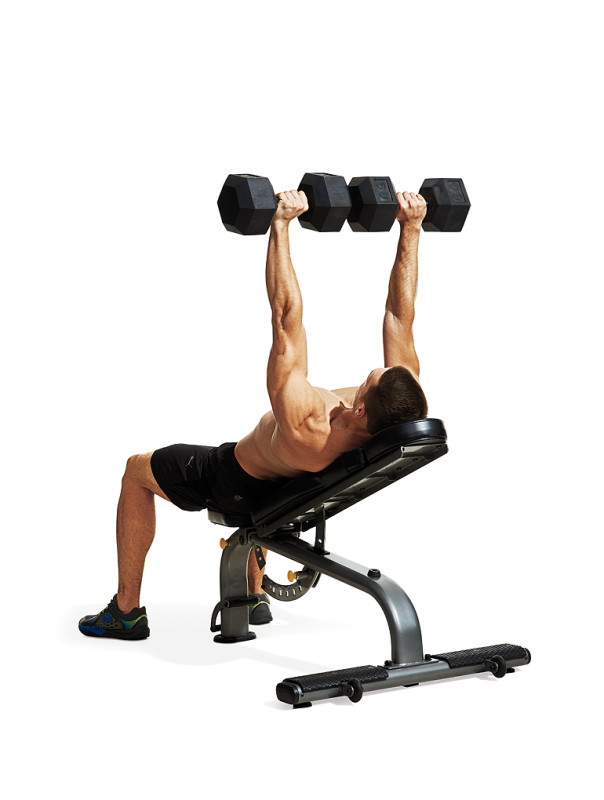
How to do it:
- Set an adjustable bench to a 30°-45° angle and lie back on it with a dumbbell in each hand at shoulder-level.
- Press the weights over your chest.
7. Dumbbell Half Flye
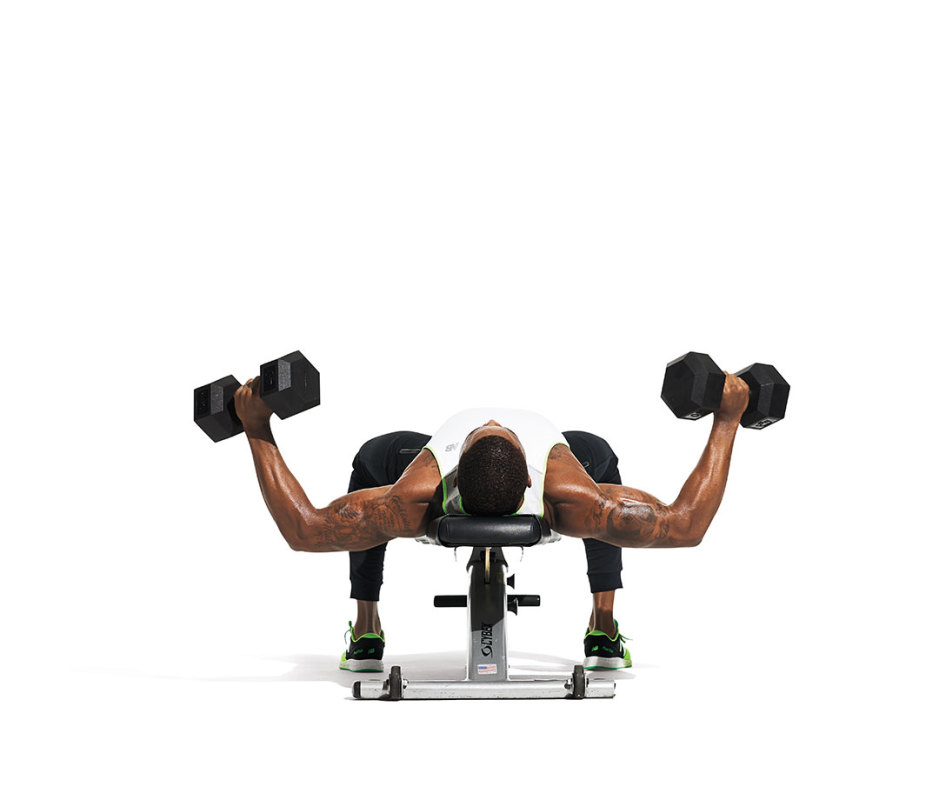
How to do it:
- Lie back on a flat bench with a dumbbell in each hand, held above your chest. Lower the weights out to the side, opening your arms wide.
- Feel a stretch in your pecs. Bring the weights halfway up, then return them back to the bottom position. That’s one rep.
- Take three seconds to lower your arms and three to bring them halfway up on each rep.
8. Dumbbell Flye
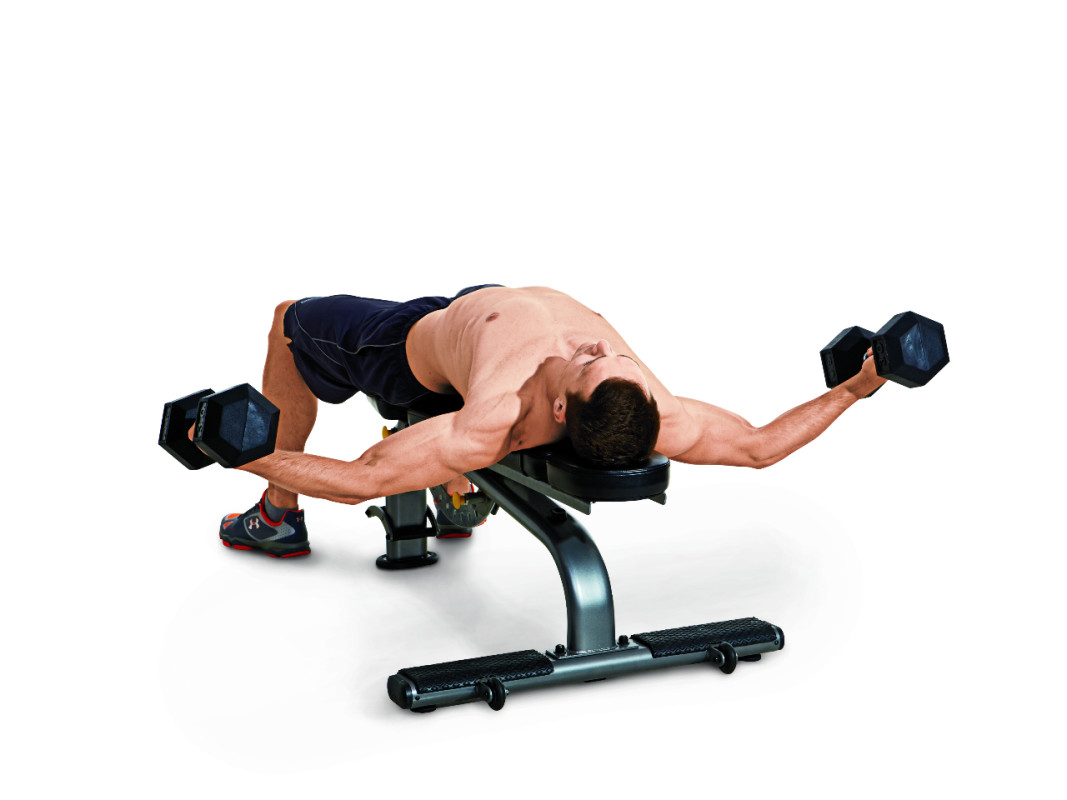
How to do it:
- Lie back on a flat bench with a dumbbell in each hand.
- Keep a slight bend in your elbows and spread your arms wide, lowering the weights until they’re even with your chest.
- Flex your pecs and lift the weights back to the starting position.
9. Incline Dumbbell Flye
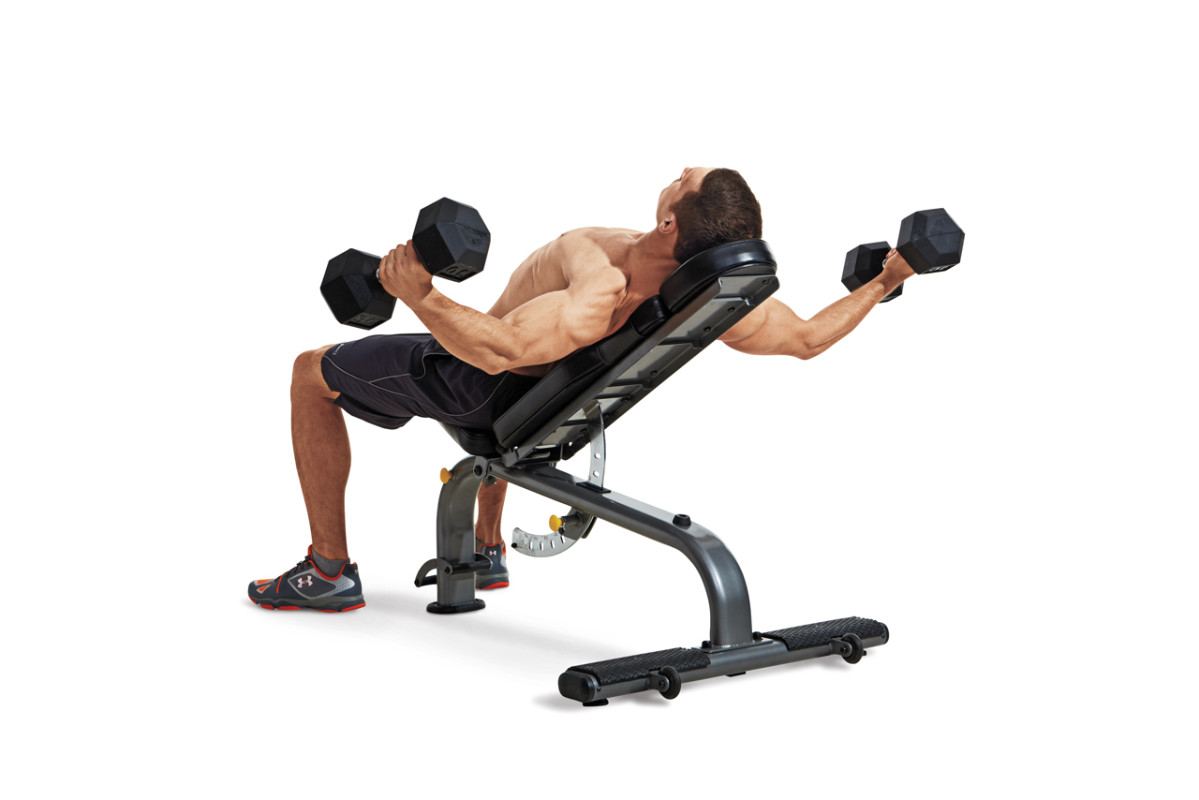
How to do it:
- Set an adjustable bench to a 30°-45° angle, and lie back on it with a dumbbell in each hand.
- Turn your wrists so your palms face each other.
- Press the weights straight over your chest, then, keeping a slight bend in your elbows, spread your arms open as if you were going for a big bear hug.
- Lower your arms until you feel a stretch in your pecs, then bring the weights back together over your chest.
10. Low-Incline Press
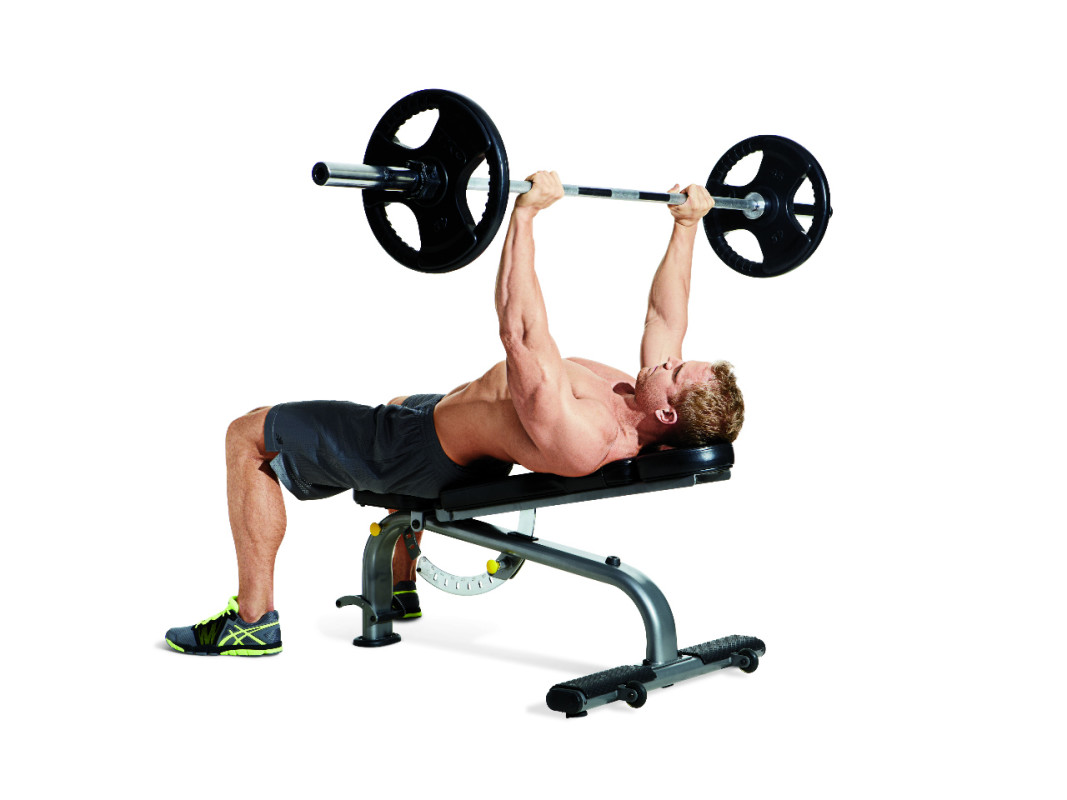
How to do it:
- Set an adjustable bench to an incline of no more than 30°, or rest a flat bench on a weight plate or mat to tilt it slightly.
- Grasp the bar just outside shoulder-width, and arch your back so there’s space between your lower back and the bench.
- Pull the bar out of the rack and lower it to your sternum, tucking your elbows about 45° to your sides.
- When the bar touches your body, drive your feet hard into the floor and press the bar back up.
11. Speed Bench Press
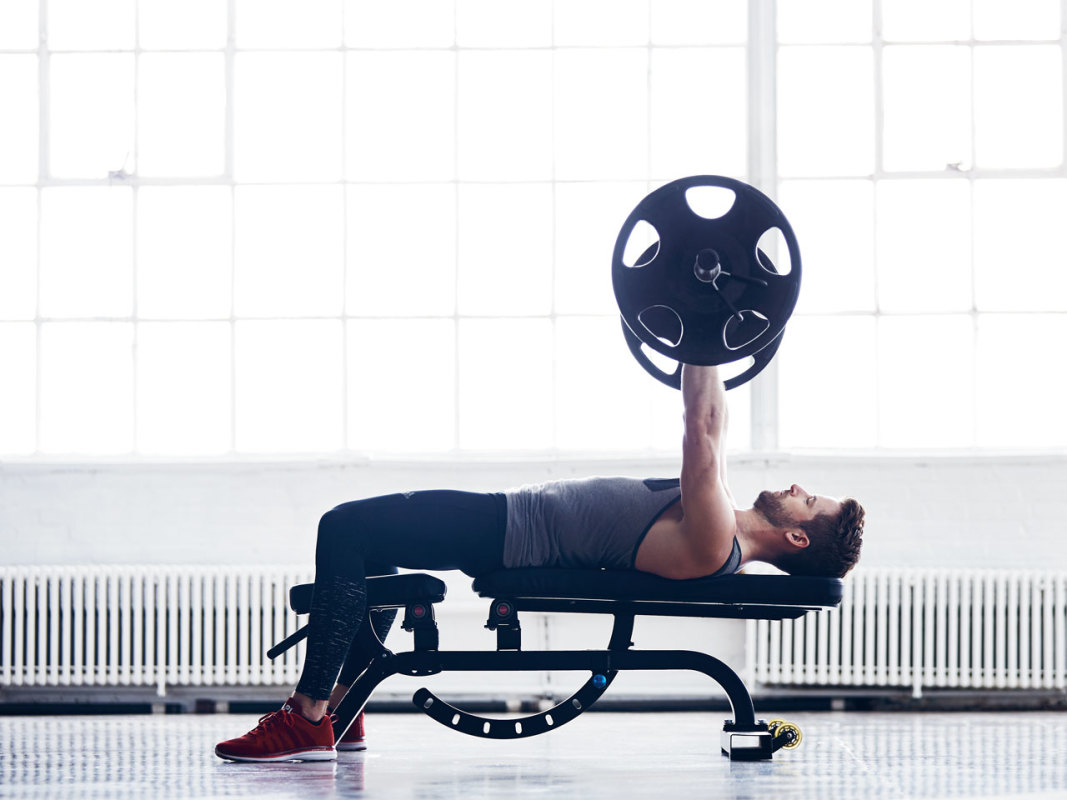
How to do it:
- Bench press as described above, but do so on a totally flat bench.
- Use 60% of your max.
- So if you think you can bench press 250lbs one time, perform your sets with 150, exploding each rep off your chest as fast as you can.
12. Landmine Press
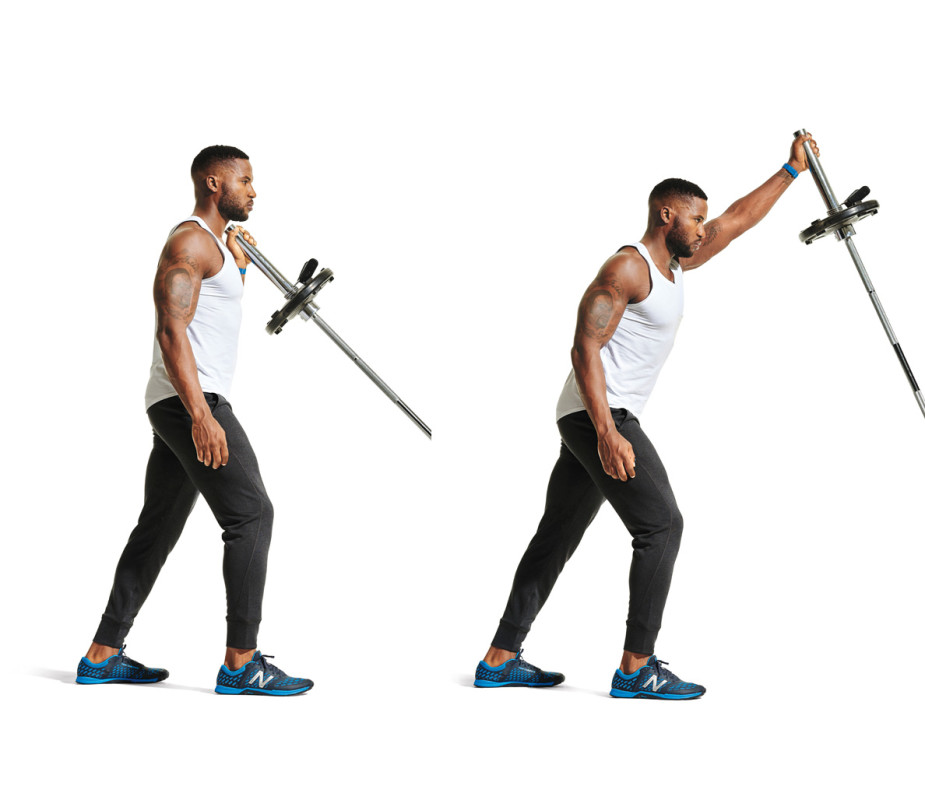
How to do it:
- Wedge the end of the barbell into a corner of the room (to avoid damage to the walls, you may have to wrap a towel around it).
- Load the opposite end with weight and grasp it toward the end of the barbell sleeve with your right hand.
- Stagger your stance so your left leg is in front. Press the bar straight overhead.
13. Floor Press
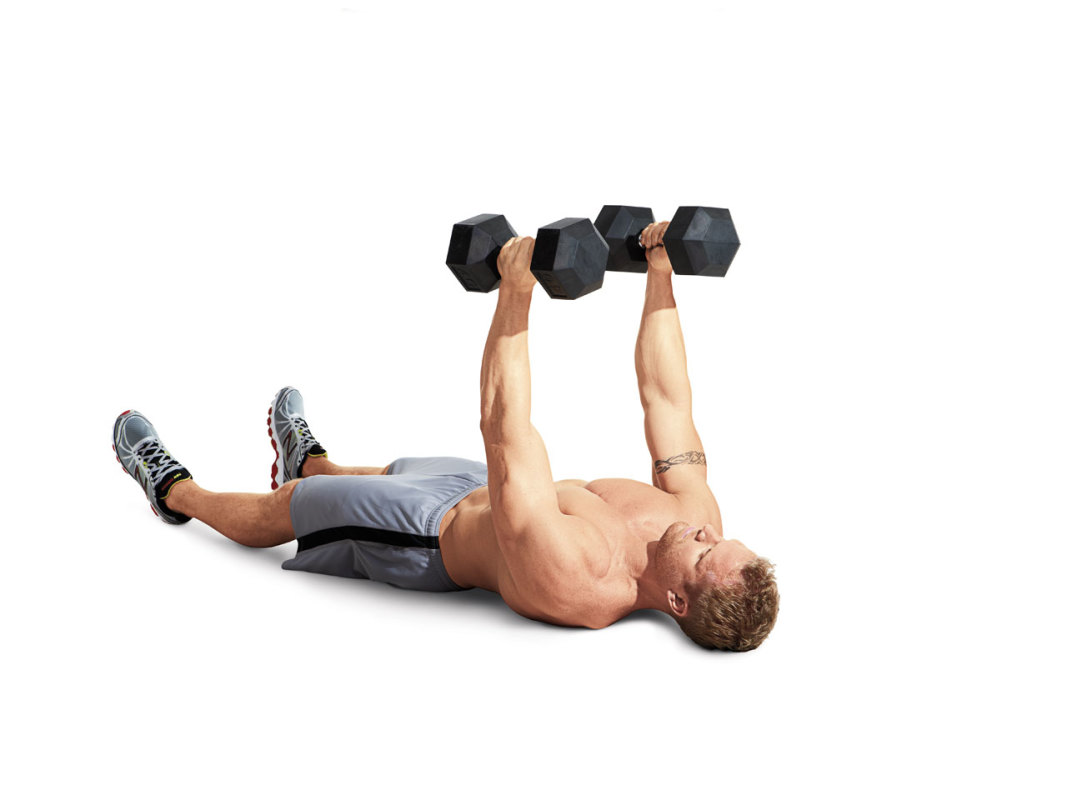
How to do it:
- Lie on the floor with a dumbbell in each hand.
- Your palms should face each other and your triceps (but not your elbows) should rest on the floor.
- Explosively press the dumbbells up.
- Lower them until only your triceps touch the floor.
- Pause for a moment, then begin the next rep. Increase the weight gradually each set.
14. Prone Flye
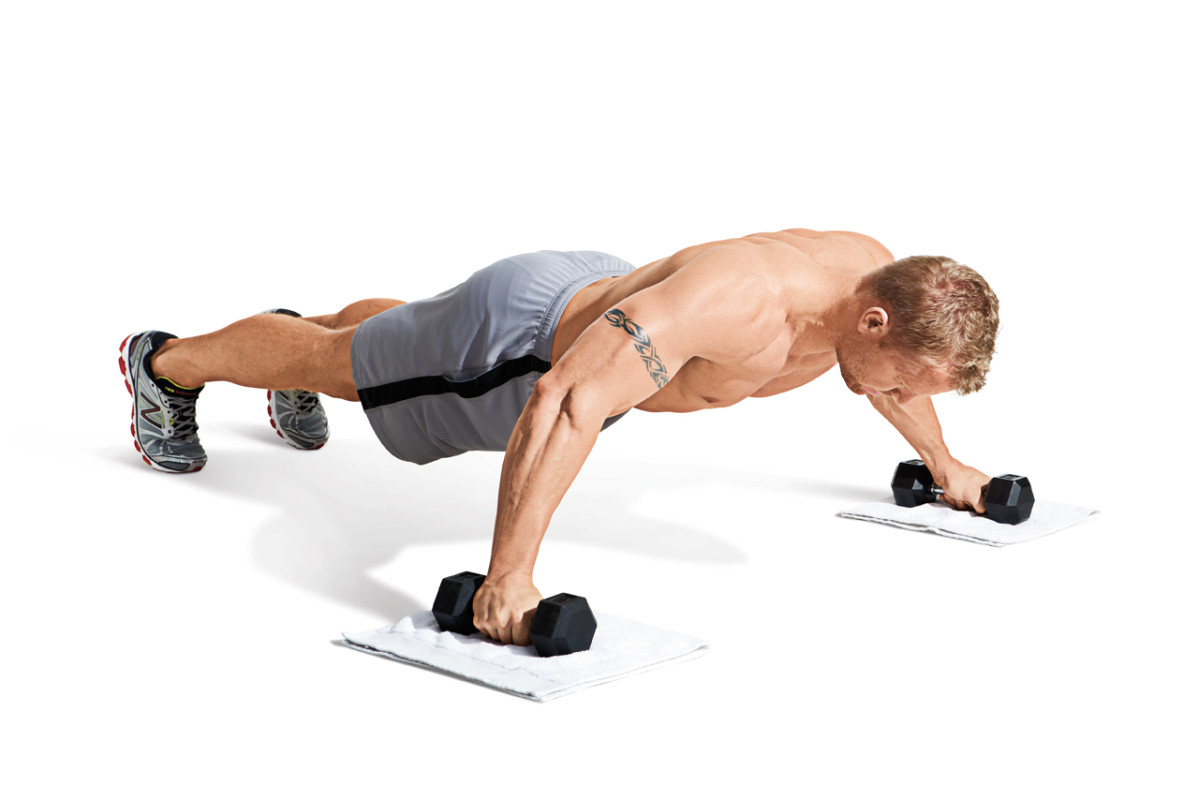
How to do it:
- Hold a dumbbell in each hand and get into a pushup position on the floor with palms facing each other.
- Spread your arms apart as in a normal dumbbell flye and lower your body until you feel a stretch in your chest, then squeeze the dumbbells and bring your hands back to pushup position.
- Keep your abs and glutes braced and your back flat throughout. If you’re using plate-loaded dumbbells, you may be able to roll the weight plates on the floor during the flye.
- Otherwise, you can place a towel under each dumbbell to facilitate sliding. If this is too difficult, perform the exercise on your knees.
15. Pullover
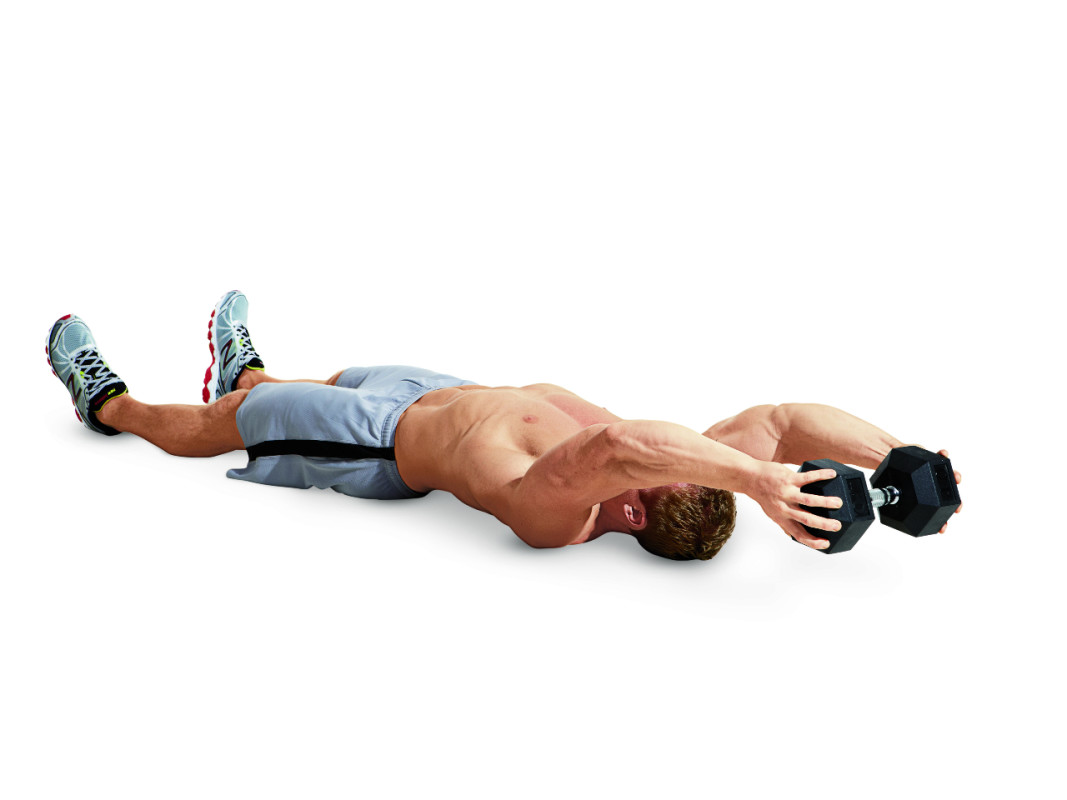
How to do it:
- Lie on your back on the floor and hold one dumbbell overhead with both hands.
- Press the weight over your chest, then reach back over your head, bending your elbows only slightly.
- Continue until you feel a stretch in your lats, then pull the dumbbell back over your chest.
- Take a deep breath every time you lower the dumbbell behind you.
16. Plate Pressout
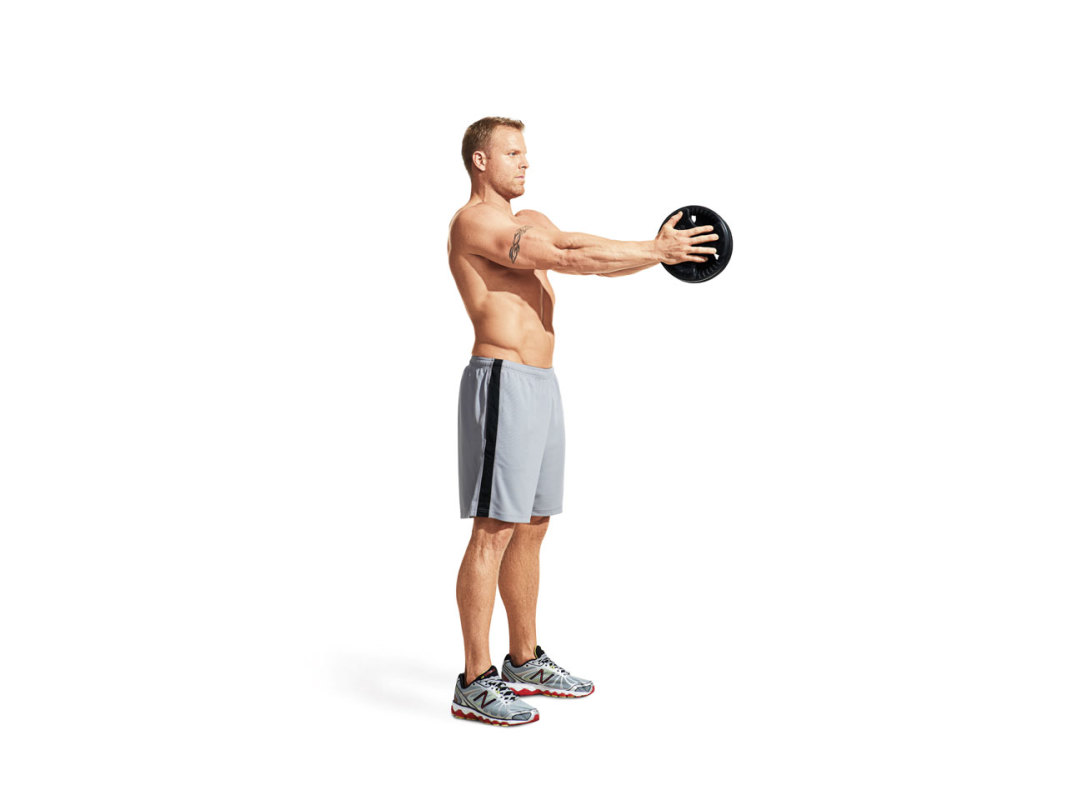
How to do it:
- Hold a pair of light weight plates together, smooth side out, between your palms right in front of your chest.
- Squeeze the plates together, focusing on your chest, and press them out in front of you until your arms are extended.
- Flare your lats and pull the weights back to your chest.
- Complete your reps and then, on the second set, press the weights downward from your chest at a 45-degree angle.
- On the third set, press them upward at a 45-degree angle.
17. 3-Way Suspension Trainer Flye
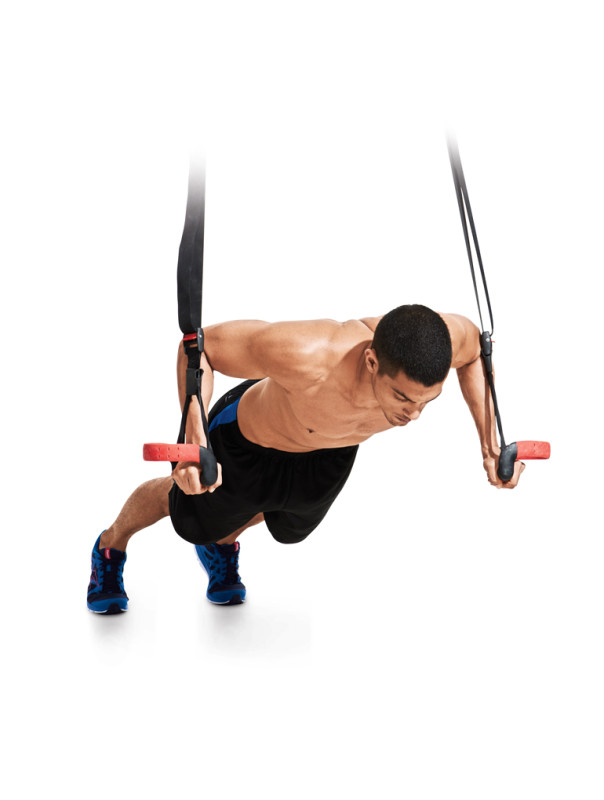
How to do it:
- Attach a suspension trainer to a sturdy overhead object and lengthen the straps to a point where you would do pushups.
- Grasp the handles and get into pushup position with hands under your shoulders.
- Your entire body should be straight and your core braced.
- Bring your arms out to your sides as if you were giving someone a bear hug.
- Lower your body until you feel a stretch in your chest and then bring your arms together again.
- That’s one rep of the flye. Perform three reps.
- Then, from the starting position, open your arms but keep your elbows bent so that the move looks like a combination of a pushup and a flye.
- Press yourself back up.
- That’s one rep of the bent-arm flye.
- Perform three reps.
- From there, return to the starting position and perform pushups on the handles.
- All of the above equals one set.
18. Pushup
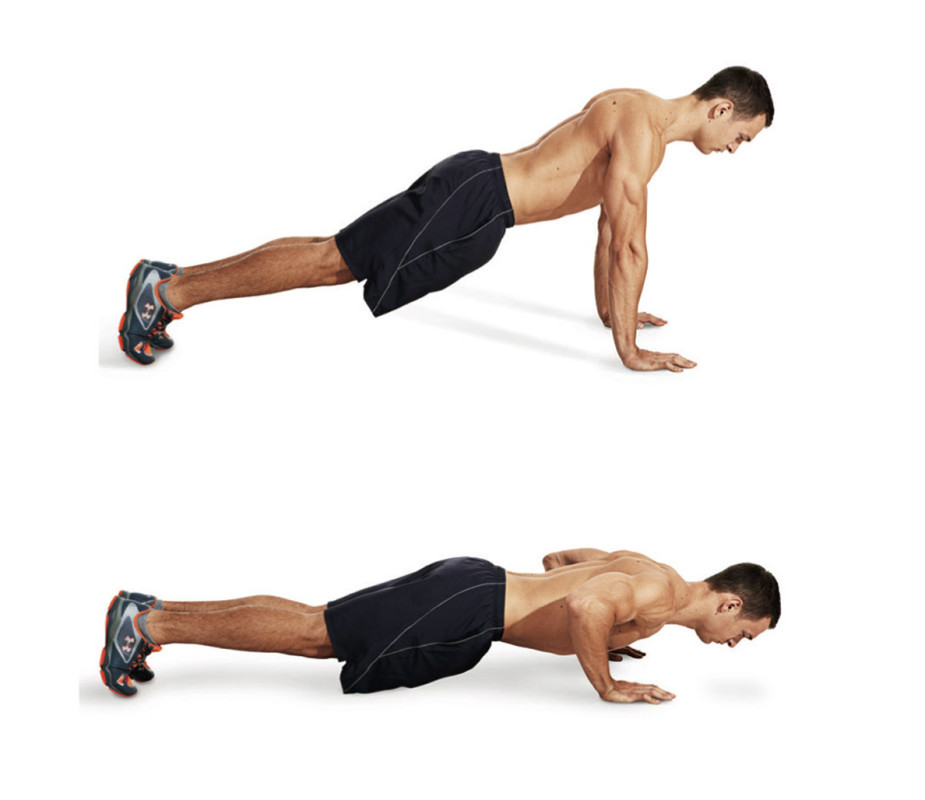
How to do it:
- Get into a pushup position with hands under your shoulders.
- Your entire body should be straight and your core braced.
- Lower your body, keeping your elbows tucked near your torso and your head neutral, until your chest is almost touching the floor.
- Fire your chest and triceps and raise your body back to the pushup position.
19. Suspension Trainer Reverse Flye to External Rotation to Face Pull
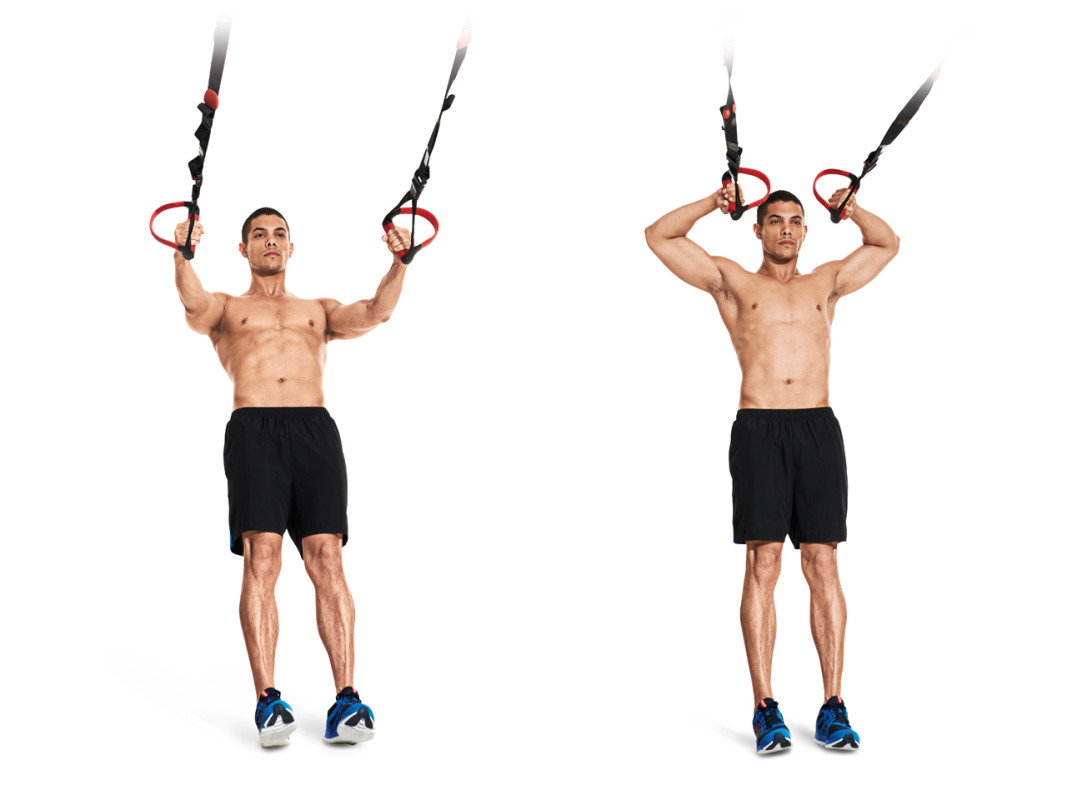
How to do it:
Reverse Flye:
- Grasp the handles and lean back away from the trainer’s attachment point so your weight is on your heels and your body is about 45 degrees to the floor.
- Allow your arms to extend in front of you.
- Squeeze your shoulder blades together and draw your arms back until they’re 90 degrees out to your sides.
- (Keep a slight bend in your elbows.) That’s one rep of the reverse flye. Perform five reps.
External Rotation:
View the original article to see embedded media.
- From the start position of the reverse flye, draw your upper arms back with your elbows bent 90 degrees and knuckles facing the ceiling.
- Your upper body should make a W shape.
- That’s one rep of the external rotation. Perform five reps.
Face Pull:
- From there, return to the starting position with arms extended and pull your hands to your forehead, twisting your palms to face in front of you as you pull.
- That’s one face pull. Perform five reps. All of the above equals one set.
20. One-Armed Medicine Ball Pushup
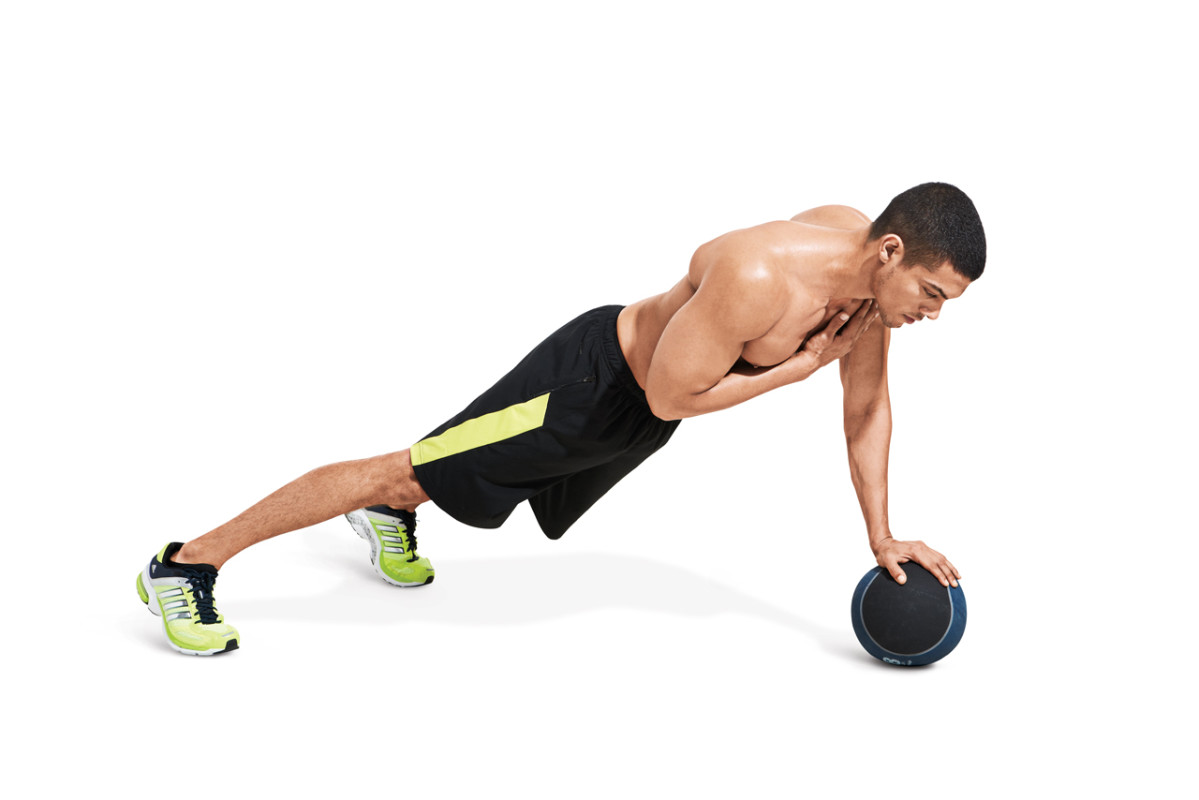
How to do it:
- Get into a pushup position resting your right hand on the medicine ball and left hand on the floor.
- Lower your body until your chest is just above the floor, then push back up.
21. Medicine Ball Pushup “Drop ‘n’ Pop”
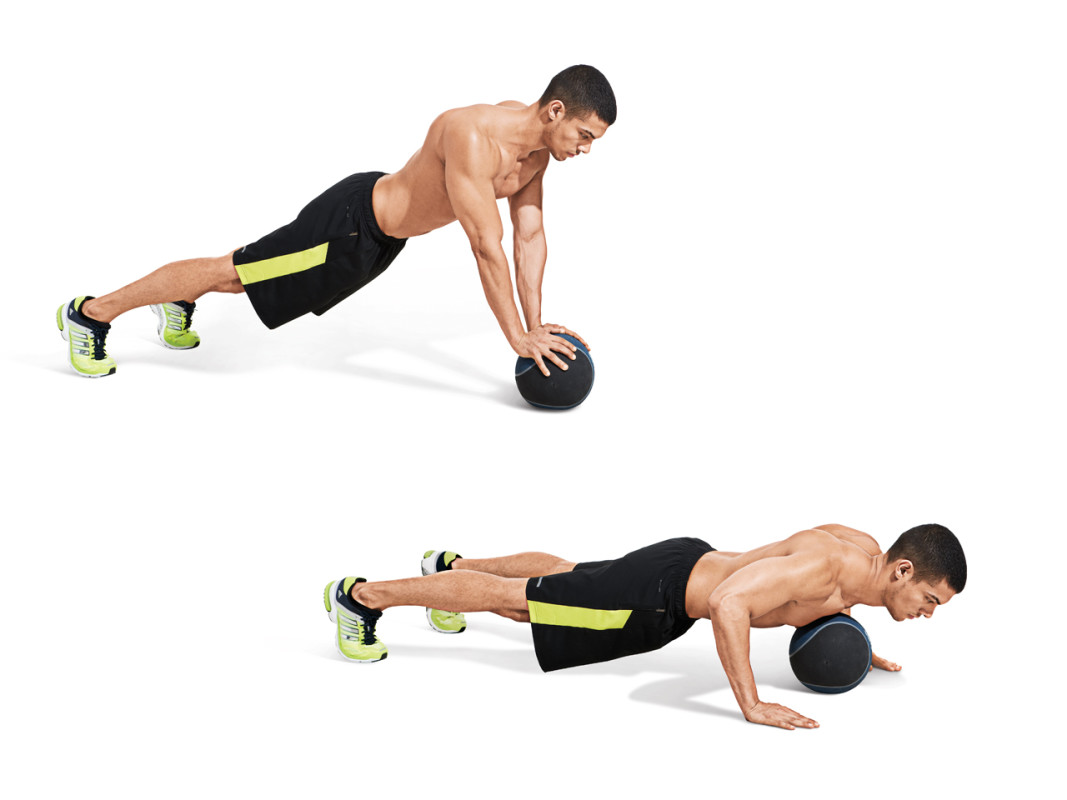
How to do it:
- Place both hands on the ball and get into pushup position.
- Quickly let go of the ball and spread your hands out to shoulder width on the floor.
- When you feel your chest touch the ball, push yourself up fast so your hands come off the floor and land on the ball again.
22. Close-Grip Pushup
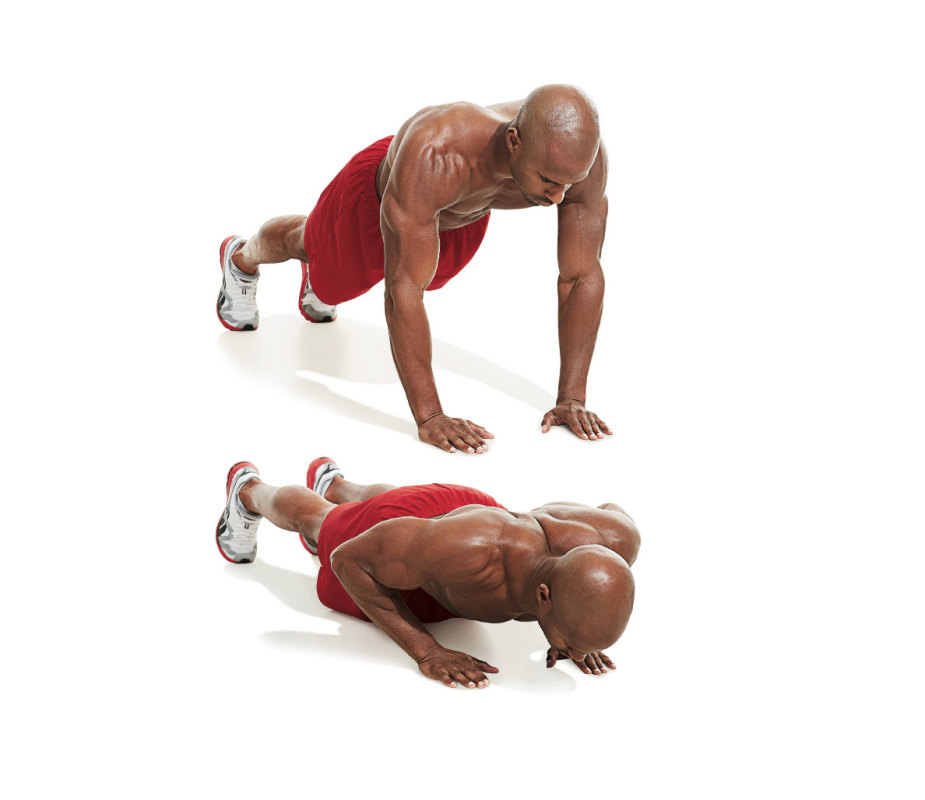
How to do it:
- Perform these as you would normal pushups, but position your hands close together.
- The closer together your hands are, the more this exercise emphasizes the triceps.
23. Medicine Ball Crossover Pushup
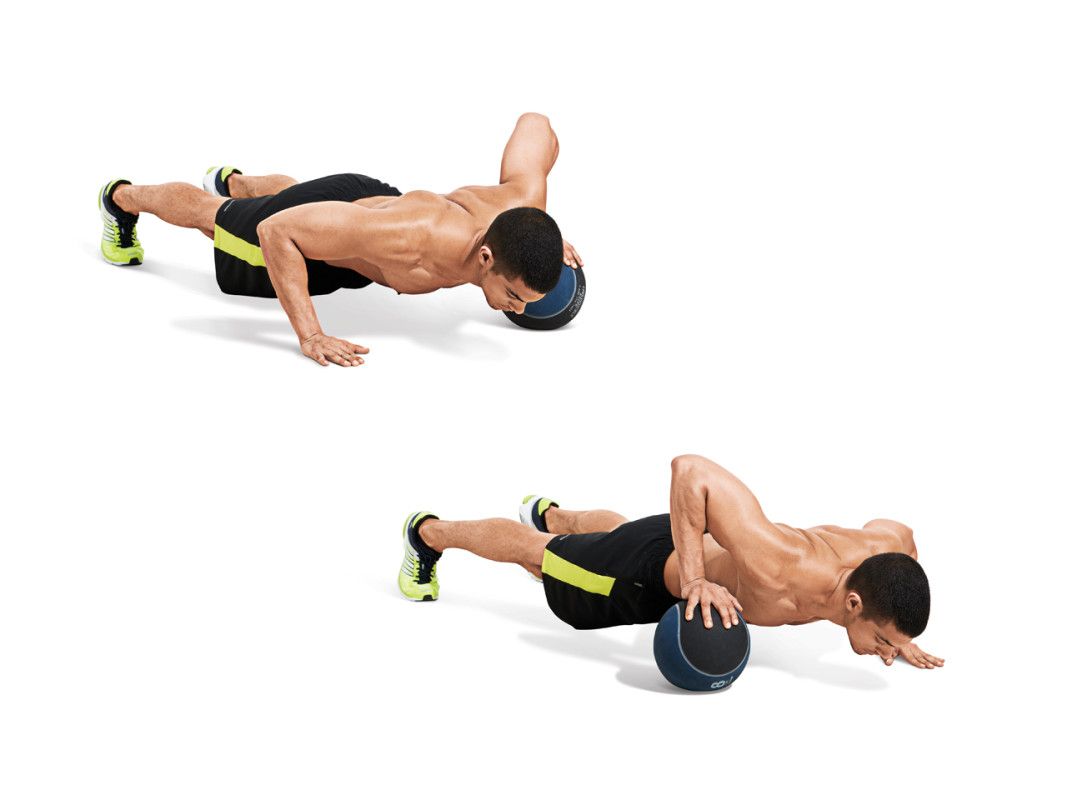
How to do it:
- Perform a pushup with one hand on the ball.
- At the top of the pushup, take your hand off the ball and roll it to the other hand.
- Put your other hand and the ball, and do another rep.
24. Plyo Pushup
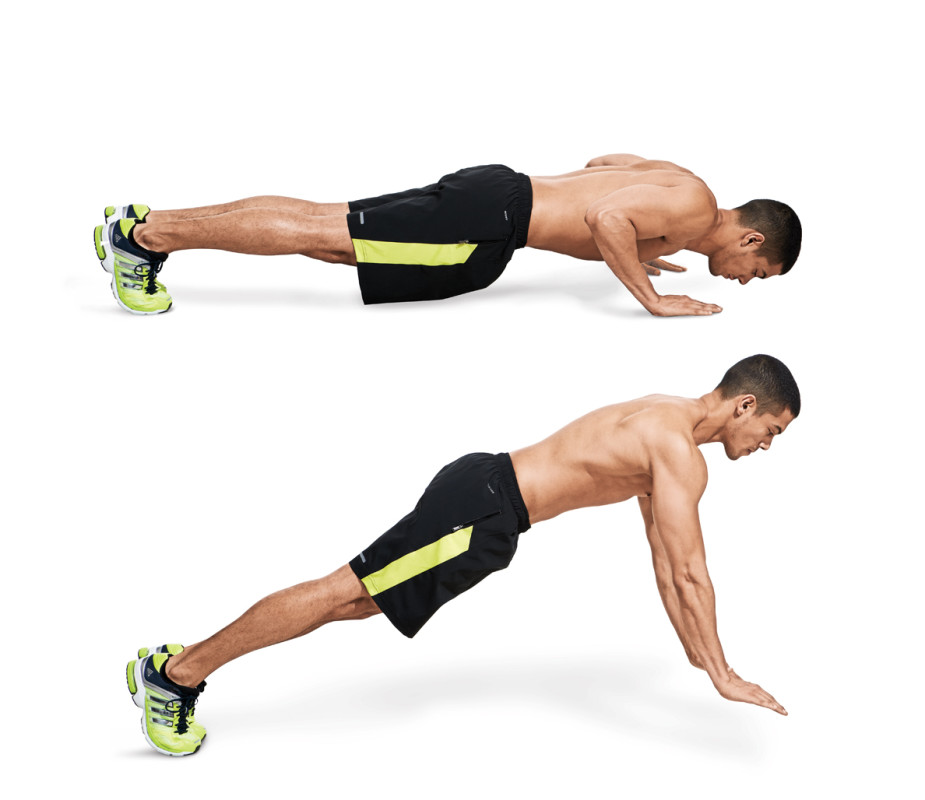
How to do it:
- Perform pushups but explode upward on each rep so your hands leave the floor and you can clap before landing.
- When you land, go immediately into the next rep. Stop the set as soon as your movement slows down, even if it’s before six reps are completed.
25. Wide-Grip Pushup
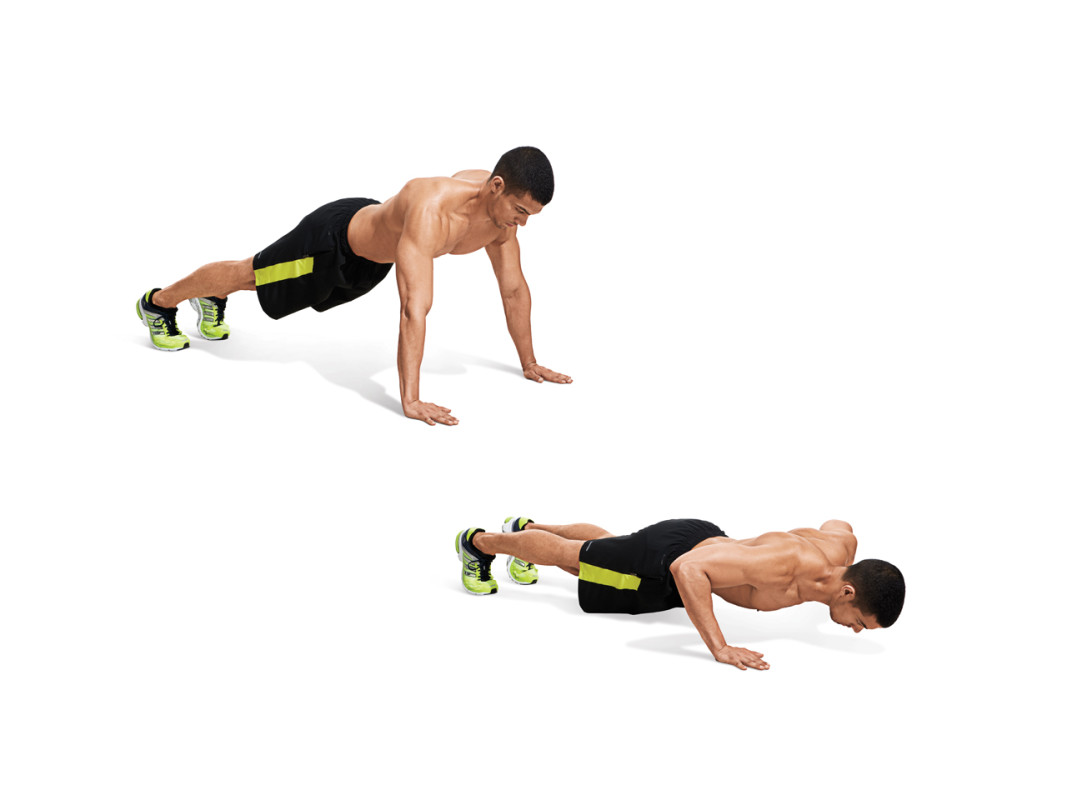
How to do it:
- Place your hands wider than shoulder width.
- Perform pushups.
26. Band-Resisted Pushup w/ Feet Elevated
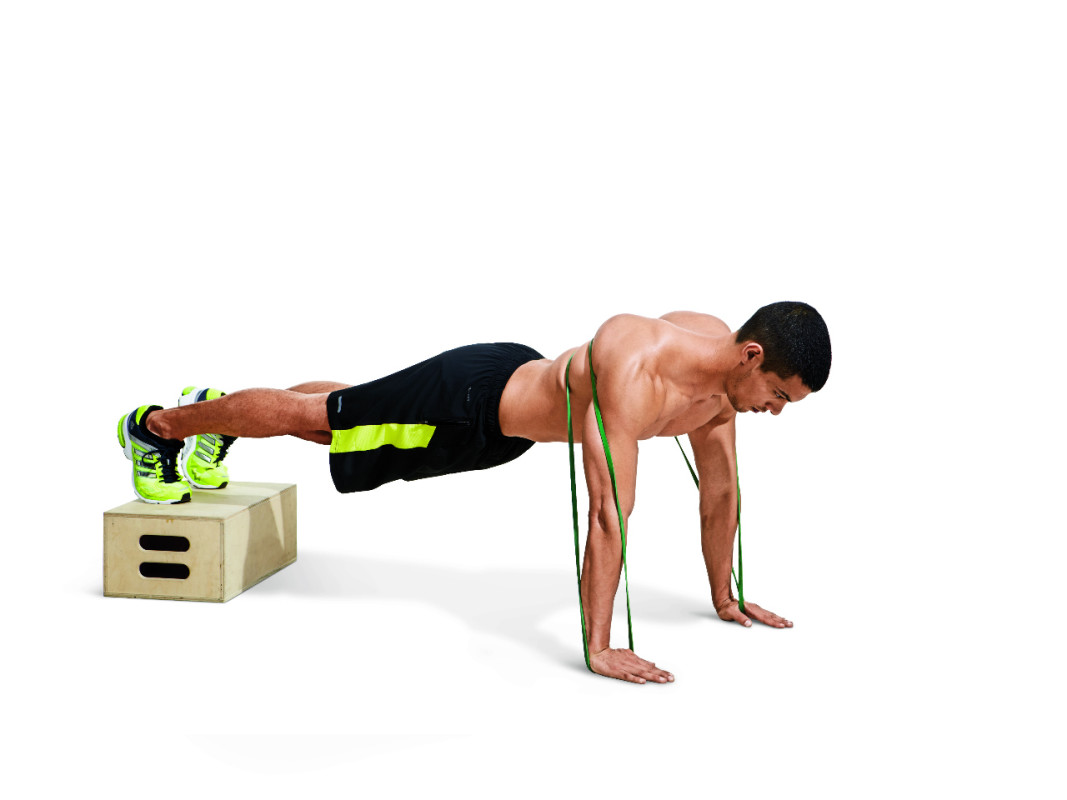
How to do it:
- Grasp the end of the band in one hand and wrap it around your back. Pin both hands to the floor with the ends of the band in your palms.
- Rest your feet on a box, bench, or mats so that your body forms a straight line parallel to the floor.
- Perform pushups.
27. Band-Resisted Flye
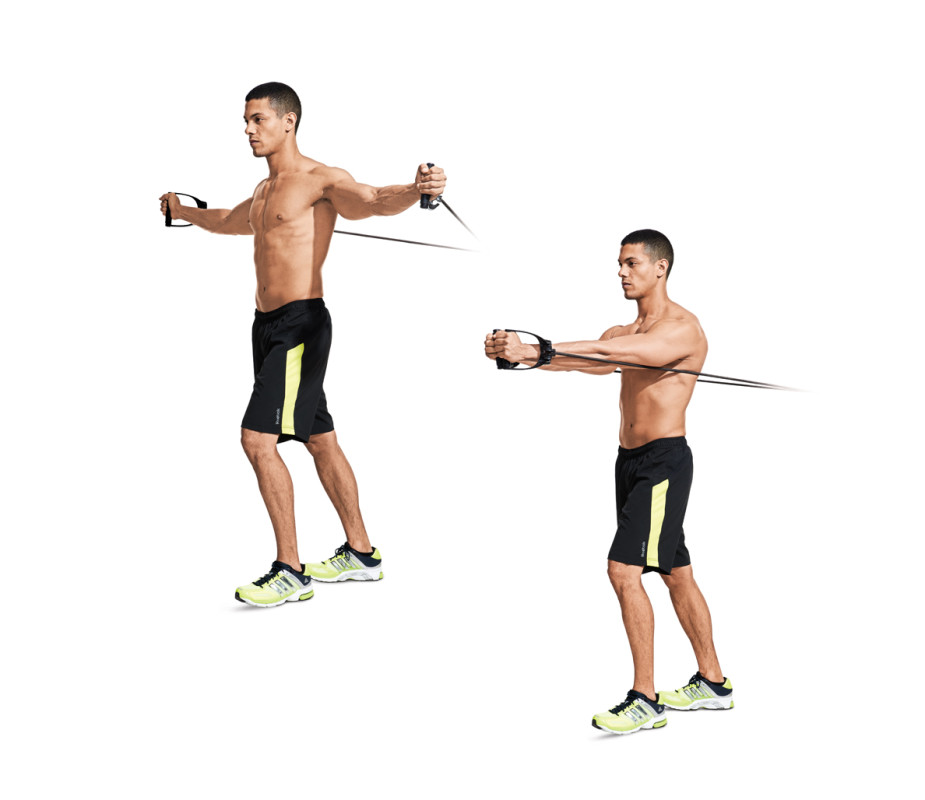
How to do it:
- Attach a band to a sturdy object at shoulder height and repeat with another adjacent to it.
- Alternatively, tie two bands together and anchor them at the same point behind you.
- Hold the opposite ends of the bands in each hand and step forward so that your arms are drawn back 90 degrees to your sides and you feel a stretch in your pecs.
- Keeping your elbows slightly bent, bring your hands together in front of your chest as if you were giving someone a bear hug.
28. Triceps Extension
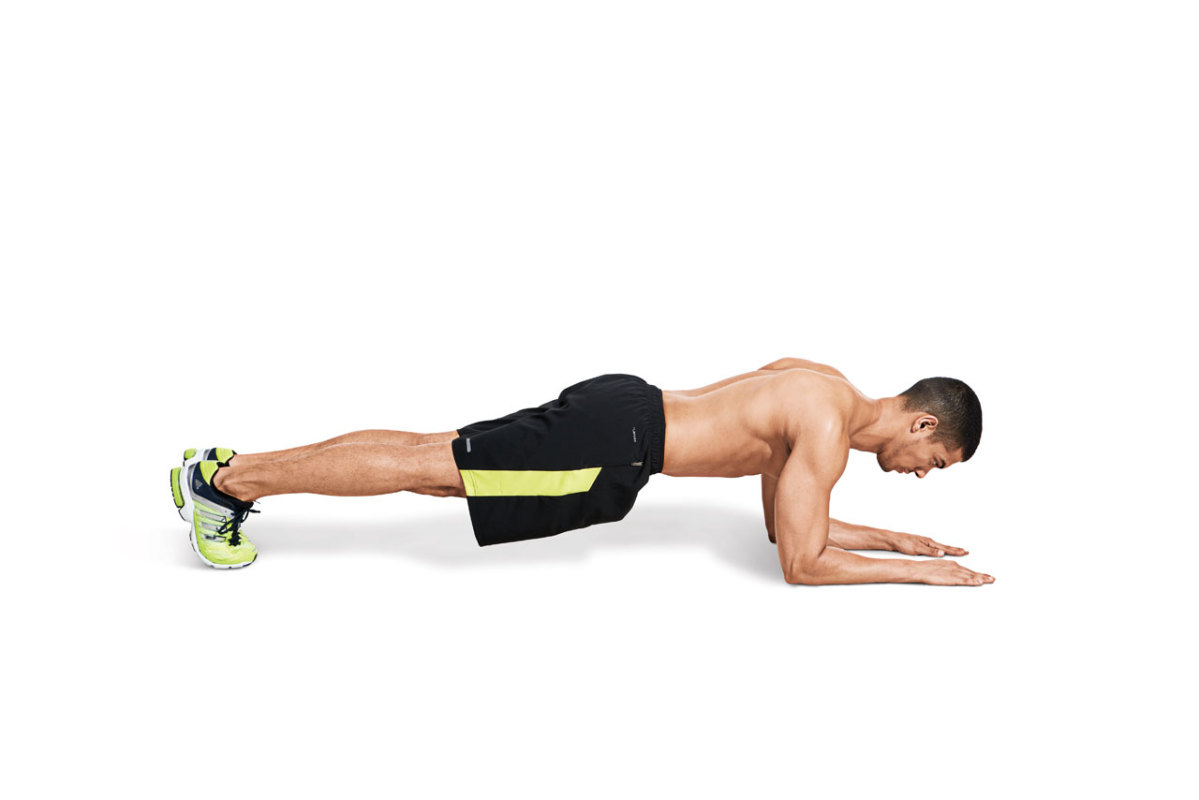
How to do it:
- Start in a pushup position, then rest your forearms on the floor with palms down.
- Keeping your core tight and your body in a straight line, extend your elbows so your arms are straight.
29. Pec Deck
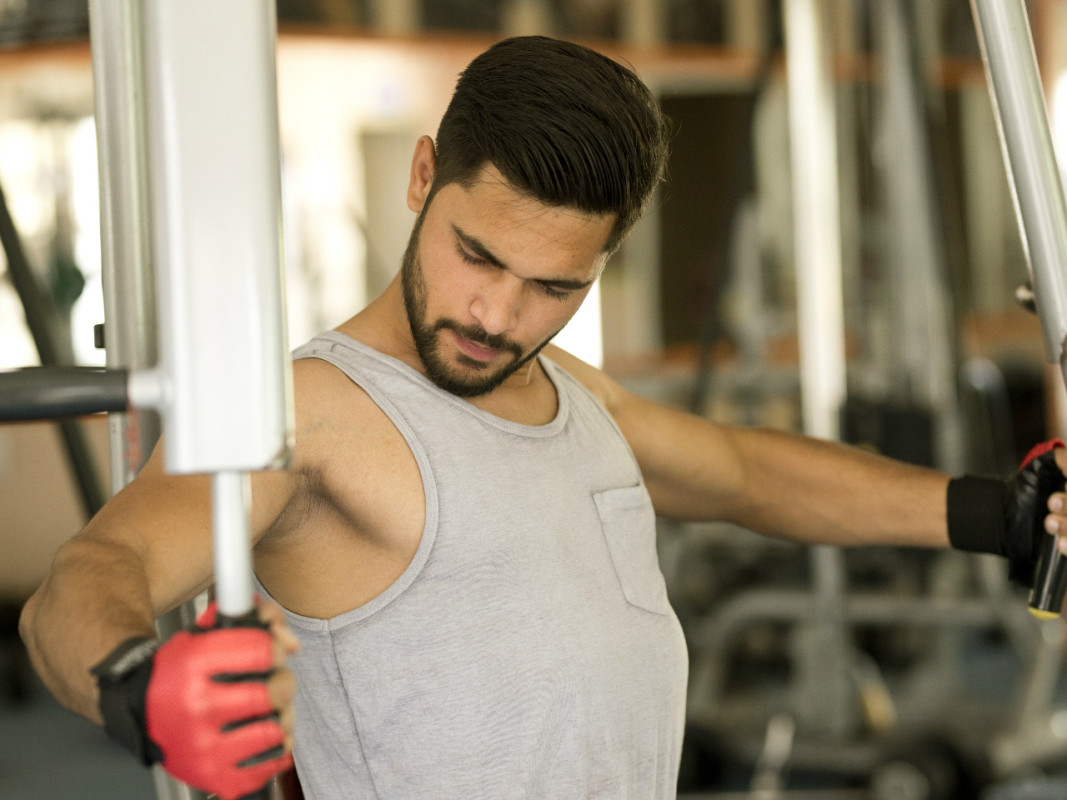
How to do it:
- Set up the Pec Deck so the vertical bars are positioned close to the machine.
- Adjust the seat so the handles are roughly chest height.
- While facing away from the machine, reach back with one hand to grab one handle, then the other.
- Pull the handles together and resist tension on the way back.
30. Wide-Grip Dips
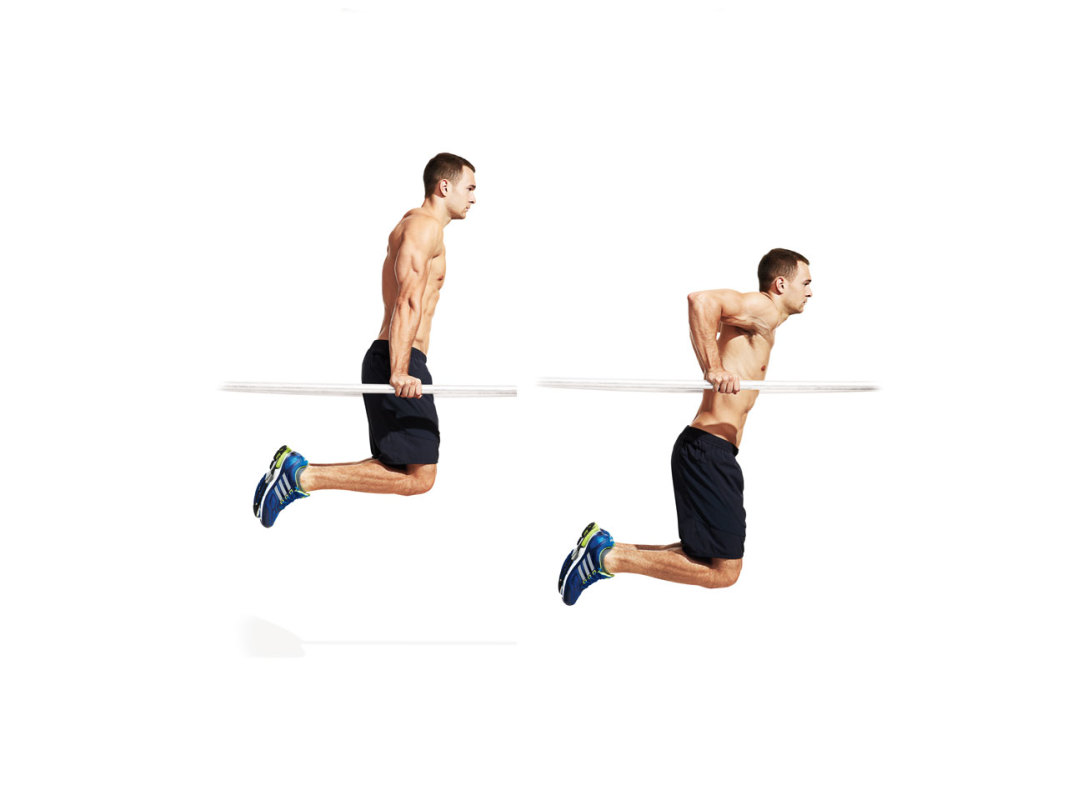
How to do it:
- Keeping your arms straight, hold your body up on two parallel bars that are a couple inches wider than shoulder-width apart.
- Descend until your chest is roughly in line with your hands, then push back up to the starting position, locking out your elbows.
- Descend while keeping your torso slightly horizontal to the ground, which emphasizes the chest muscles over your triceps.
31. Smith Machine Incline Press
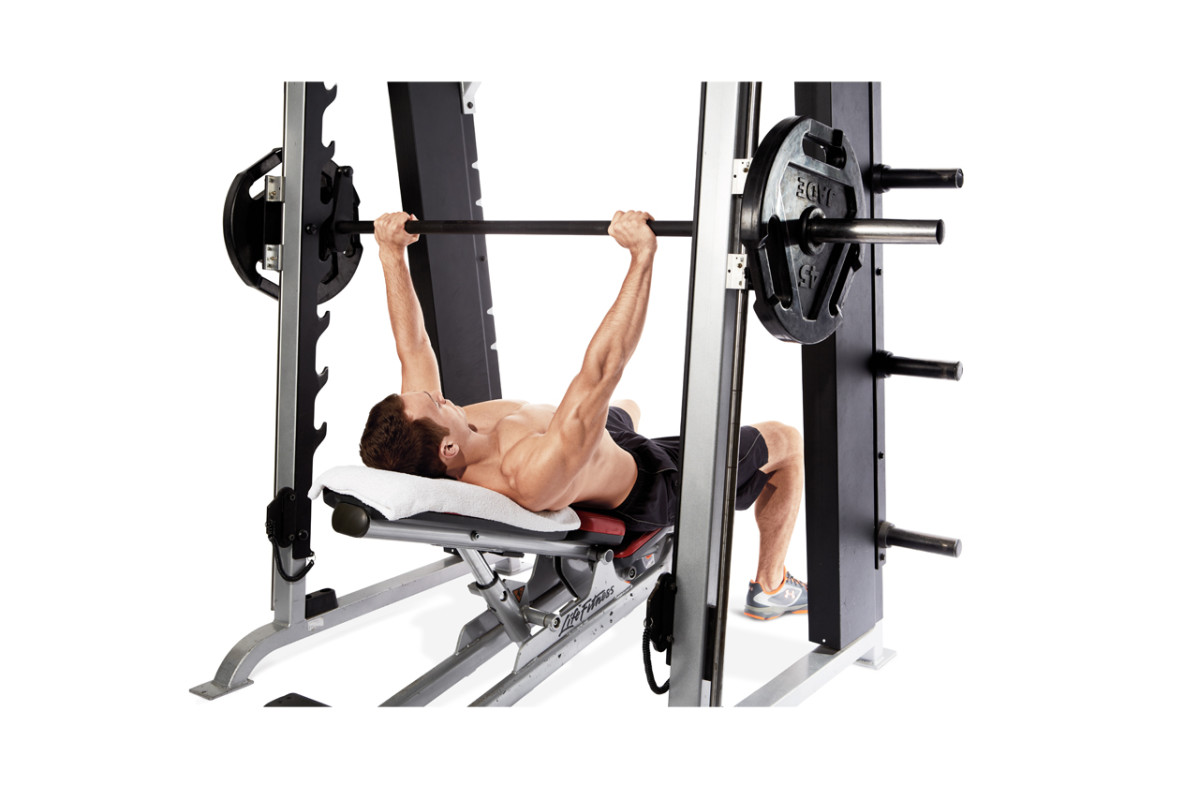
How to do it:
- Set an adjustable bench to a 30°-45° incline, and roll it into the center of a Smith machine rack.
- Grasp the bar with an overhand, shoulder-width grip.
- Unrack the bar, lower it to the upper part of your chest, and press straight up.
32. Low-Cable Crossover
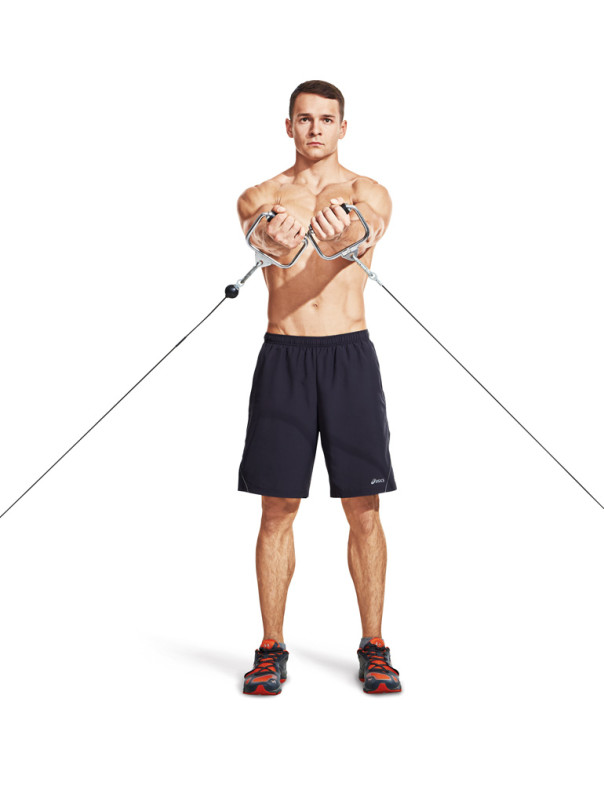
How to do it:
- Stand between two facing cable stations and attach a D-handle to the low pulleys on each.
- With a handle in each hand and elbows slightly bent, raise your arms from waist height to out in front of your chest, flexing your pecs as you bring them together.
33. Decline Pushup
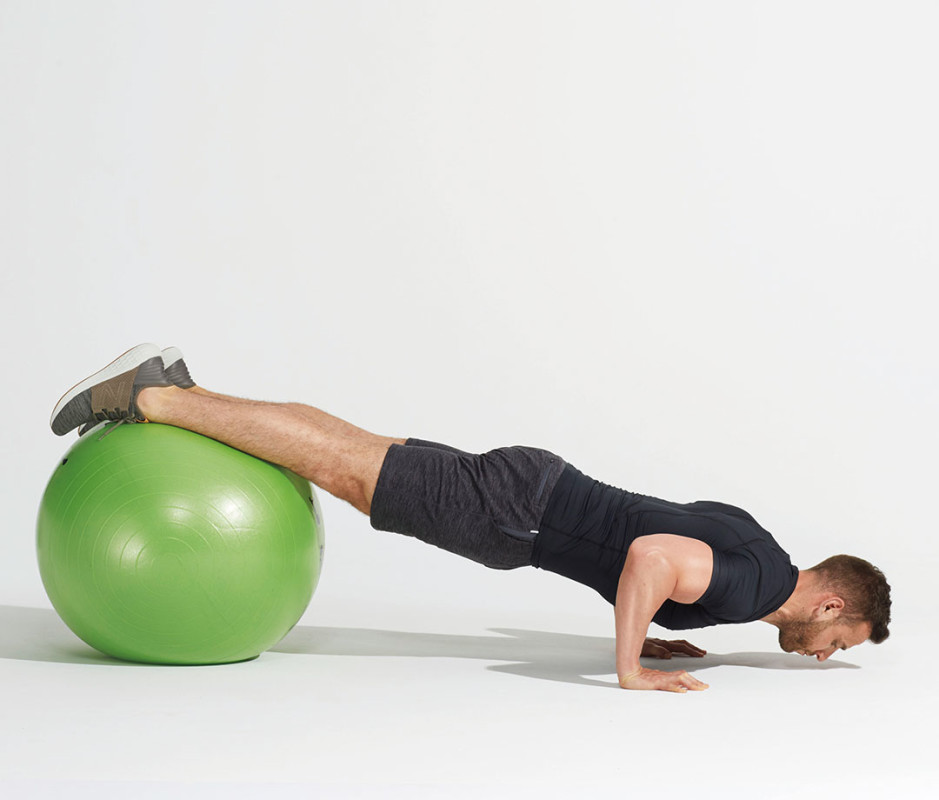
How to do it:
- Start with hands on the floor and slightly wide, top of feet or shins resting on a physio ball.
- Engage core and lower body to stabilize, and perform pushups more slowly.
34. Back Lunge to One-Arm Chest Pass
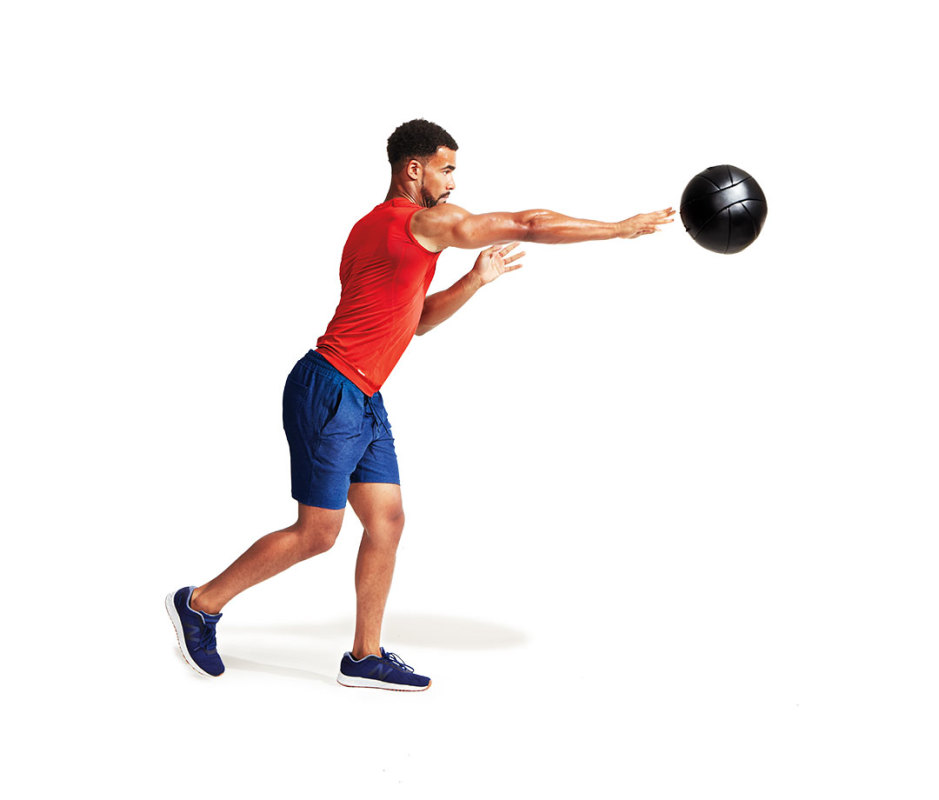
How to do it:
- Stand facing a sturdy wall, 5 feet away, with feet slightly wider than shoulder-width apart, elbows bent at rib cage, medicine ball just below sternum, and elbows pointing outward.
- Step right foot back into a lunge, rotate torso clockwise slightly, bringing ball toward your right shoulder, supporting it with your right hand.
- Keeping core tight and neck neutral, drive through left heel as you step forward with your right foot to forcefully throw medicine ball against wall with right hand. Collect medicine ball, reset, and repeat.
35. Med Ball Pushup
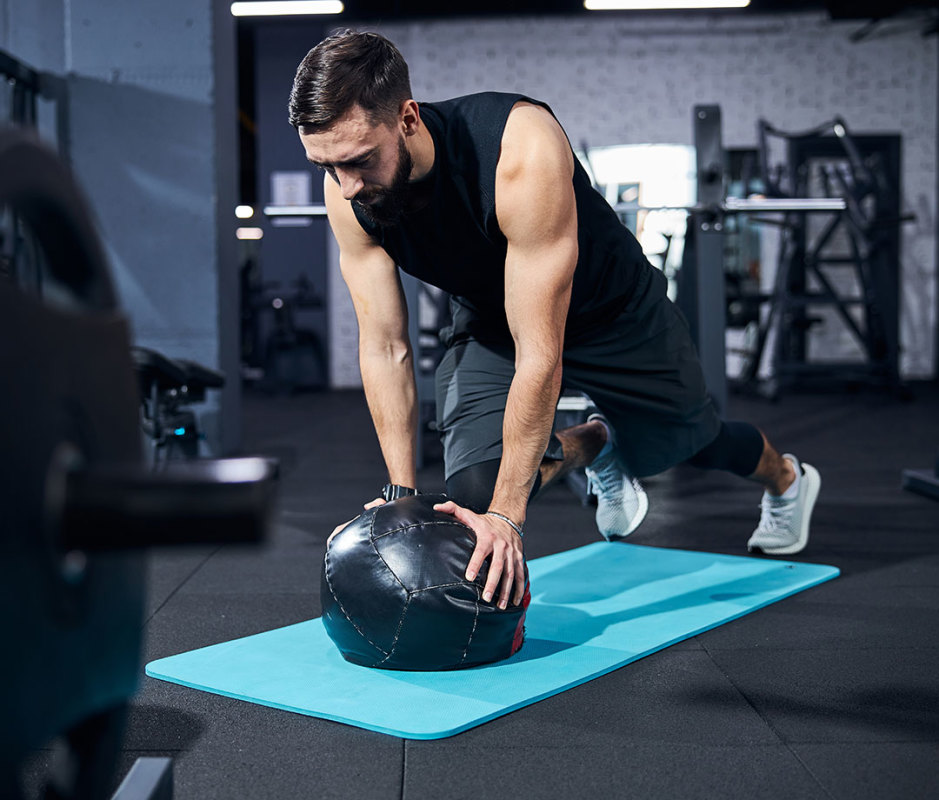
How to do it:
- Assume pushup position on a medicine or Swiss ball with fingers pointed down the sides.
- The shoulder blades should be pushed away from each other. Lower yourself to where the chest barely touches the ball.
- Maintain control of the ball as you push as far away from the ball as possible. Keep your body straight from head to ankle.
36. Medicine Ball Rotational Throw
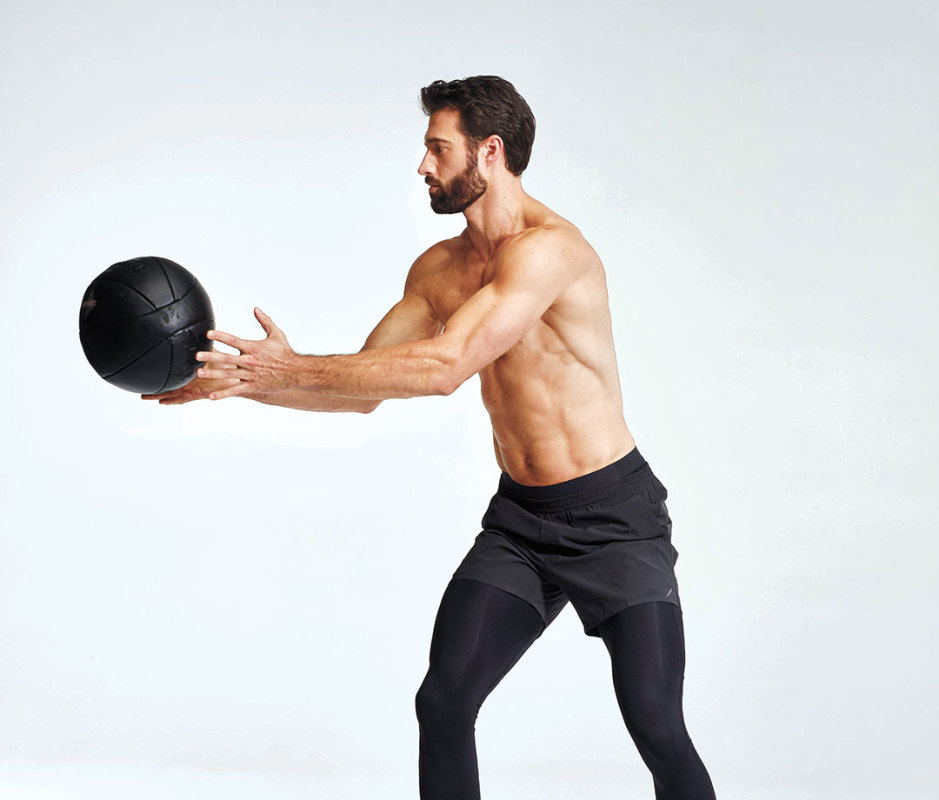
How to do it:
- Stand 5 feet away from and perpendicular to a sturdy wall, so the wall is on your right
- Keeping chin slightly down and looking at wall continuously, rotate shoulders and arms clockwise and down to bring ball by left hip.
- Powerfully twist clockwise and release ball, first rotating your hips, followed by torso, then arms, and finally the ball.
- Catch the ball and begin your next throw. Switch sides after all reps.
37. One-arm Flye Pushup
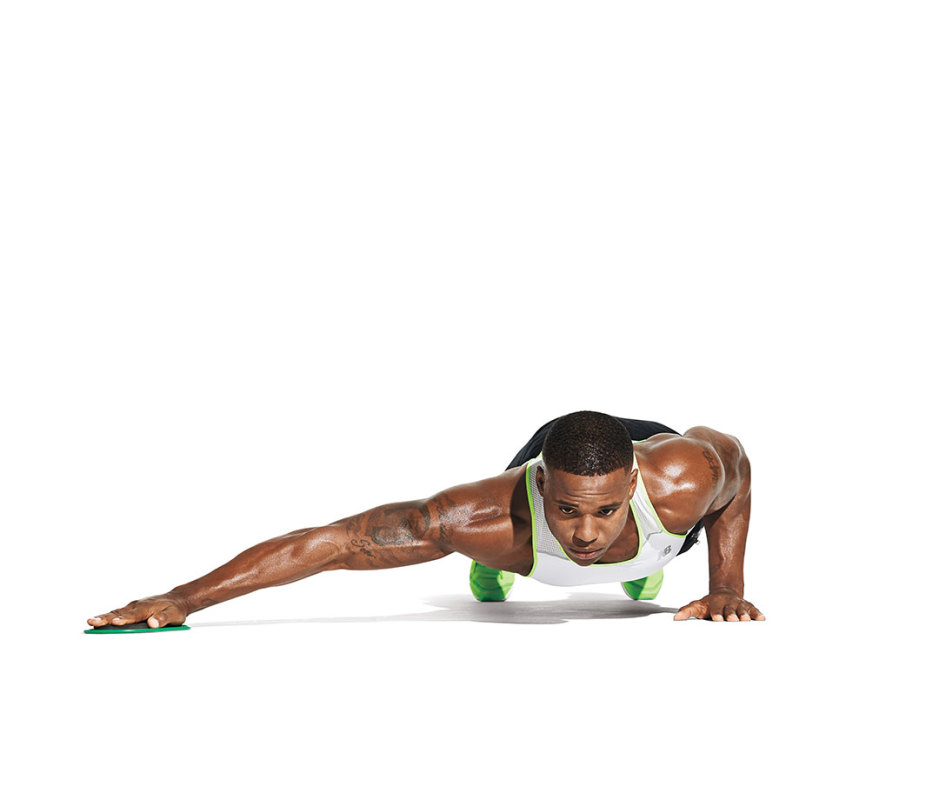
How to do it:
- Get into pushup position with one hand on a slider.
- Lower your body while sliding the hand on the slider out to the side, as if performing a flye. Keep most of your weight on the non-slider arm.
- Go as low as you safely can, then push up and draw your arm back in.
38. Chest Press Machine
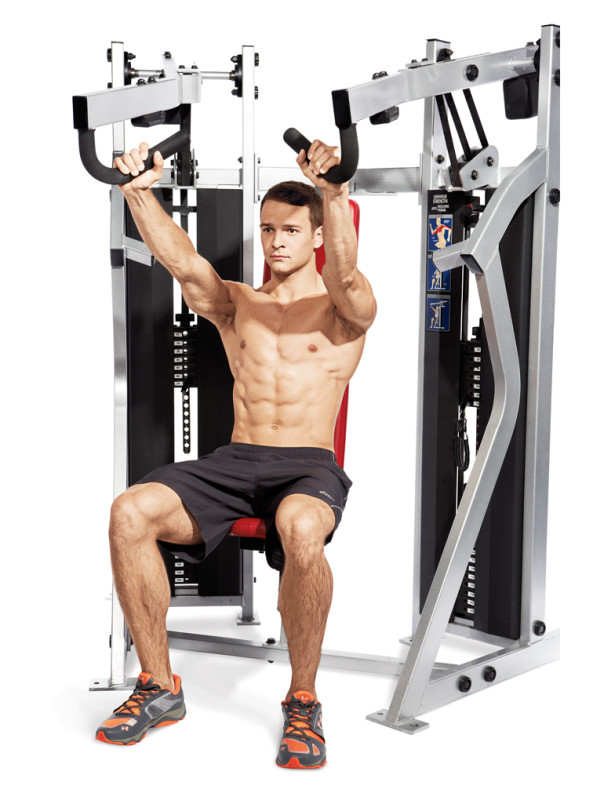
What Exactly is a Chest Press Machine?
The chest press machine engages the muscles in the upper torso. The chest muscles are the most active area of the body during this action.
What is the Purpose of a Chest Press Machine?
The chest press machine action is a strengthening workout for the chest muscles. Furthermore, it aids in the development of the muscles in the shoulder and upper arm region. The shoulders and arms are the most active components of the body during the chest press machine action. As a result, it has a direct impact on the development of the muscles in this region.
How to do it:
- Load plates on both sides of a flat-press machine, and adjust the seat so that both of your feet are flat on the floor.
- Grasp the handles and press to a full lockout.
39. Banded Chest Flye
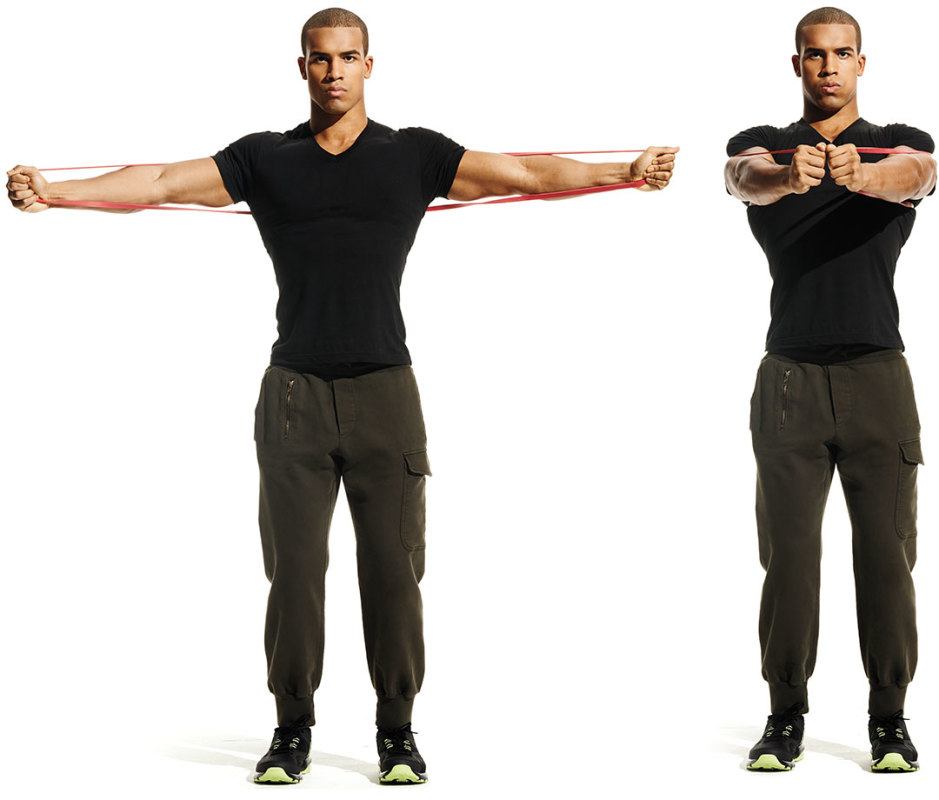
How to do it:
- Wrap a band around a sturdy object or around your back and hold an end in each hand.
- Open your arms so you feel a stretch in your pecs.
- Keeping your elbows slightly bent, bring your hands together in front of your chest as if you were giving someone a bear hug.
40. High Peak Pushup
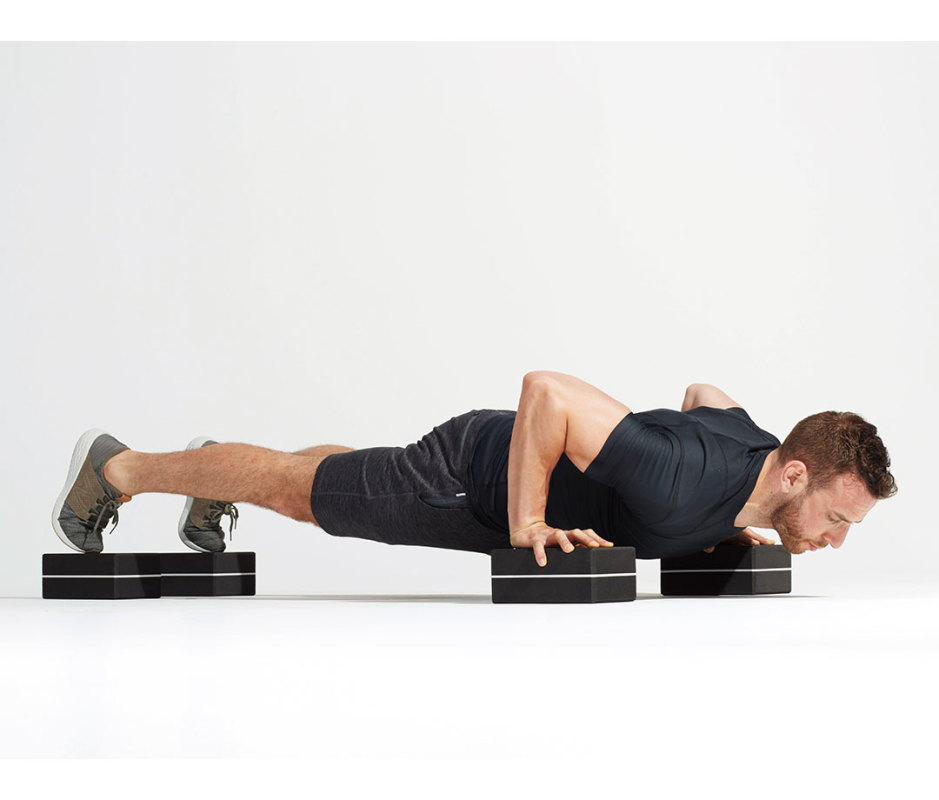
How to do it:
- Situate four yoga blocks or small plyo boxes under hands and feet, with hands wider than traditional pushup position.
- Drop chest below hand level while maintaining a straight back, then press back up into plank position. As you get stronger, bring blocks under feet slightly closer together.
41. Spiderman Pushup
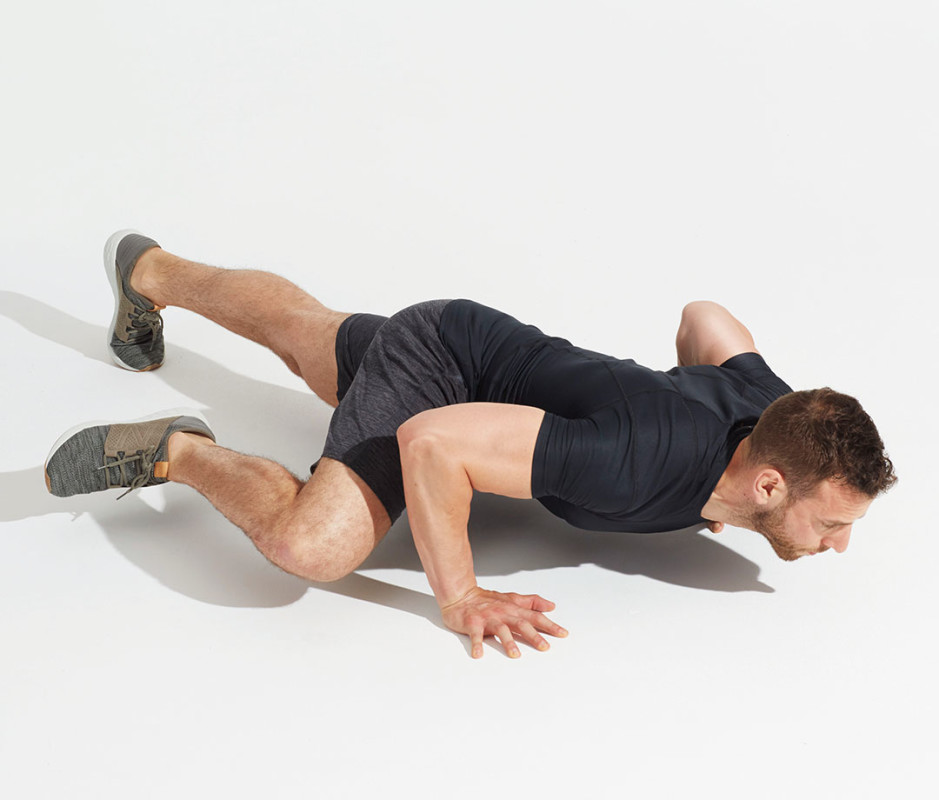
How to do it:
- Start in plank position, arms extended and your body in straight line.
- Bend elbows, keeping them close to your sides to initiate the movement.
- As you lower your body to the floor, bend your left knee and touch it to left elbow. Return to plank position. Repeat by touching your right knee to your right elbow.
42. Plank to Pushup
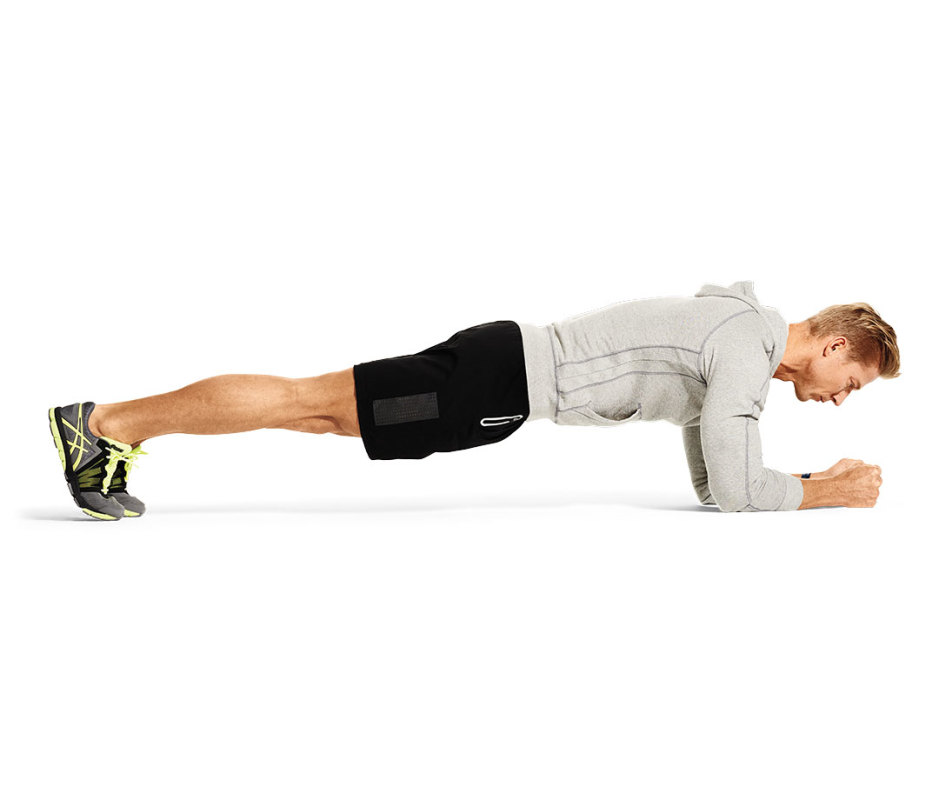
How to do it:
- Begin in a forearm plank.
- Push from your triceps, placing your right hand on the ground, then your left hand, gradually rising to pushup position.
- Return to the forearm plank by placing your right forearm down, then your left. Alternate which arm leads the movement.
43. One-arm Hang Snatch
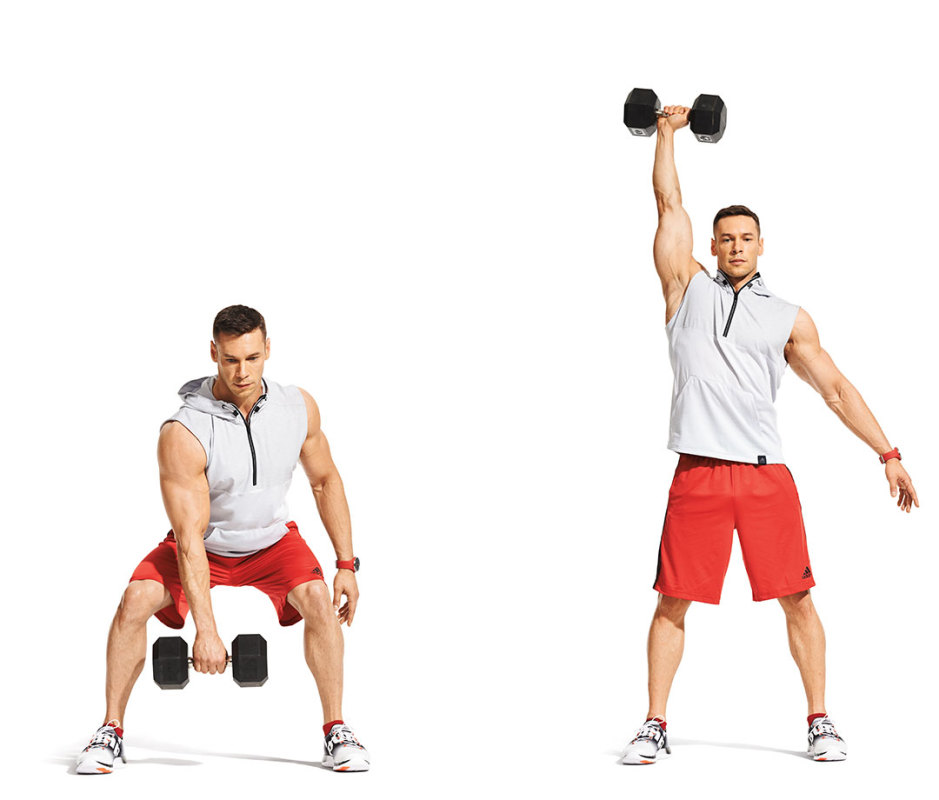
How to do it:
- It’s a full-body exercise with power coming from the hips, but your chest is the unsung contributor of this move providing stability in the “catch” phase.
- Stand with feet shoulder-width apart while holding a dumbbell straight down in front of you. Keeping your back flat and chest up, push your hips back and down to lower the weight between your knees.
- Explode in one motion, extending the hips quickly and pulling the dumbbell straight up. When the weight reaches maximum height, drop your body underneath and catch it overhead. Lower back to starting position, and repeat; switch sides after all reps.
44. Split-Stance Head-to-Hip
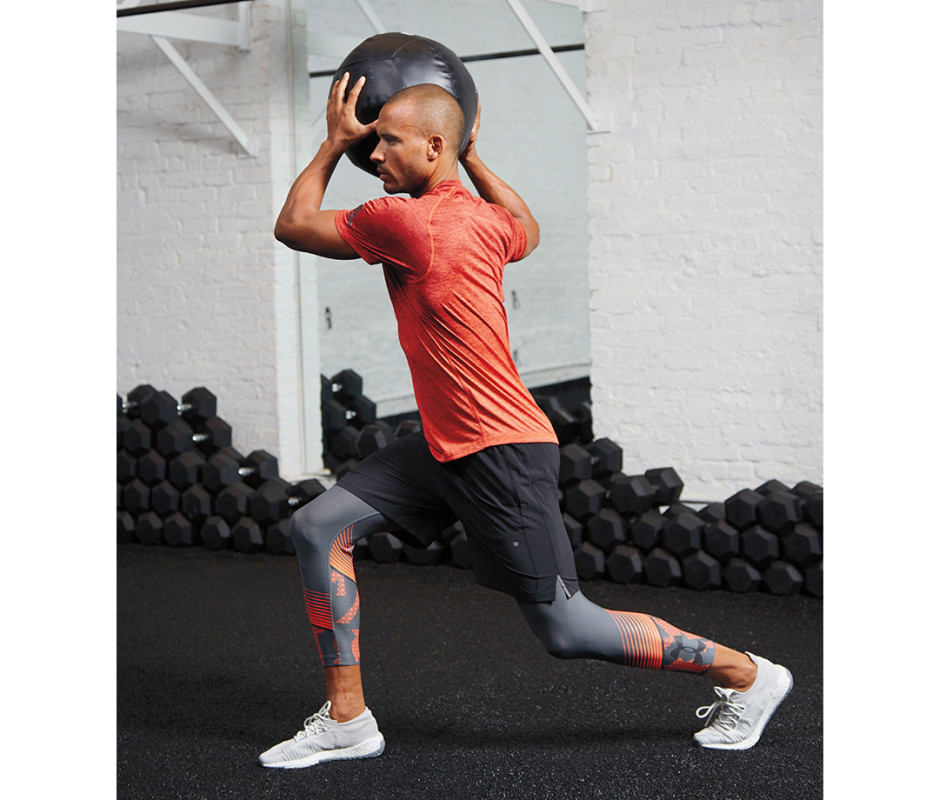
How to do it:
- Stand in a split stance three feet in front of a wall holding a medicine ball at chest level with your arms straight.
- Bring the ball to your chest and throw it as hard as possible against the wall.
- Catch the ball and go immediately into your next throw. Midway through the set, switch legs.
- *From this split-stance position, you cann also throw a medicine ball from chest level with arms straight. Catch the ball and go immediately into your next throw. Midway through the set, switch legs.
45. Medium Cable Flye
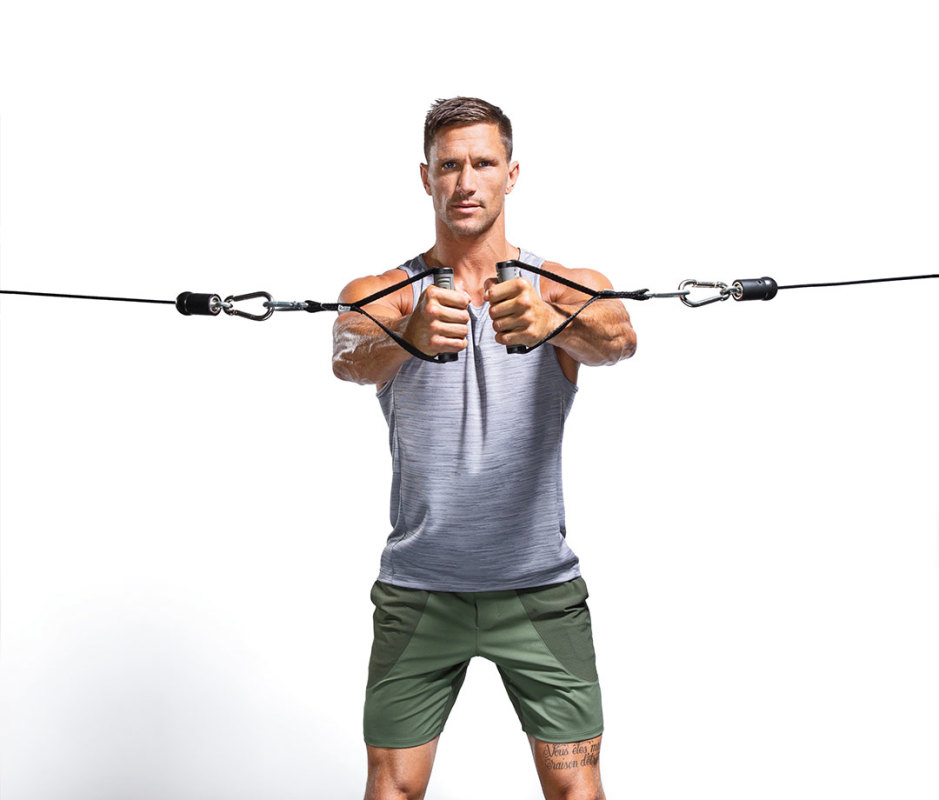
How to do it:
- Attach a D-handle to both cable pulley attachments. Grab one in each hand and walk out a few feet so there’s tension in the cables.
- Keeping elbows up and slightly bent, fists parallel to shoulders, press hands around and forward to meet each other, like you’re hugging a tree. Reverse for 1 rep.
46. 3-Way Pushups
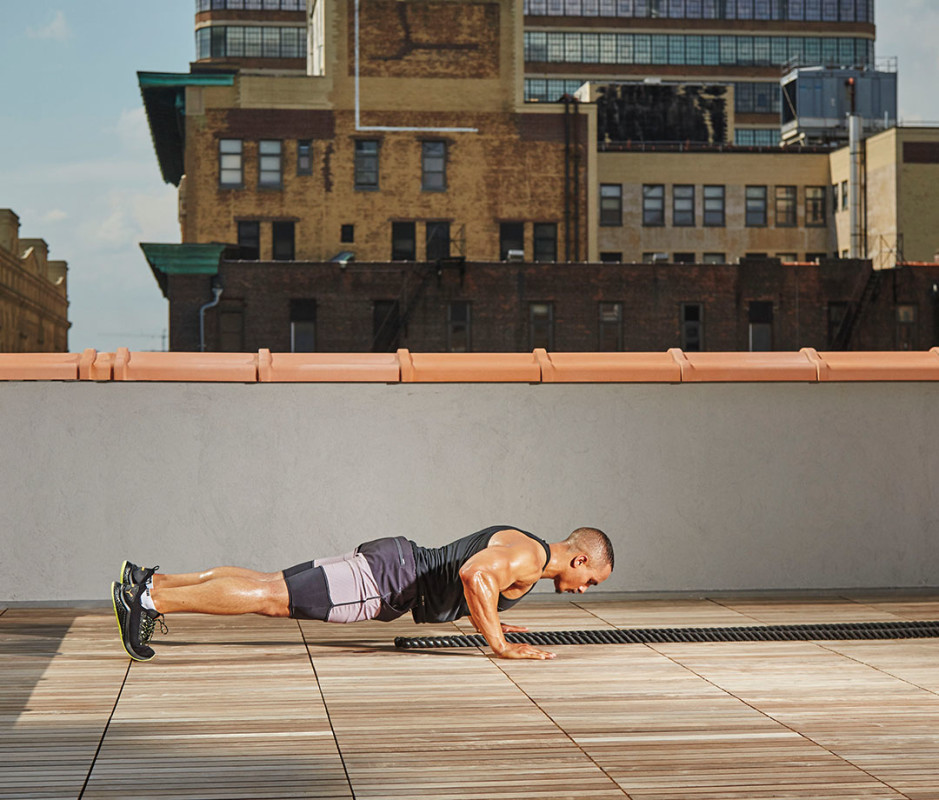
How to do it:
- Do 10 traditional pushups (hands directly under shoulders).
- Next, do 10 diamond pushups (index fingers and thumbs touching).
- Lastly, do 10 wide-grip pushups (hands wider than shoulders).
47. Burpee
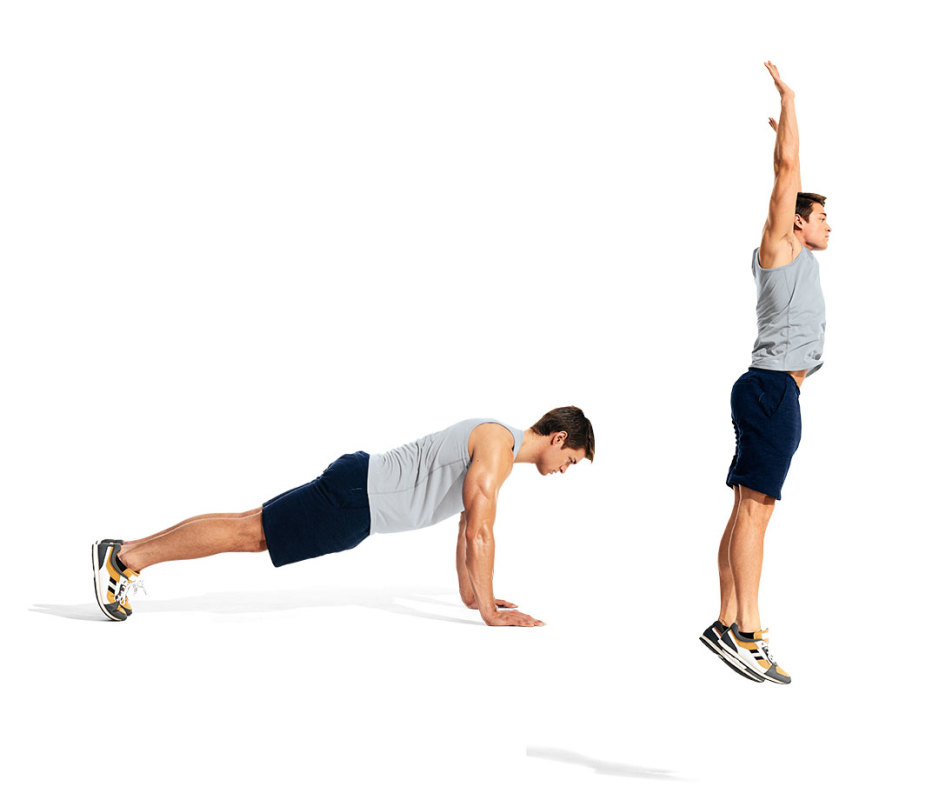
How to do it:
- From a standing position, squat, place your hands on the ground, and “jump” your feet out into a pushup.
- Perform a pushup, then jump your feet to your hands.
- Jump as high as you can, throwing your hands over your head, then immediately repeat movement.
48. Dowel Rod Pushup
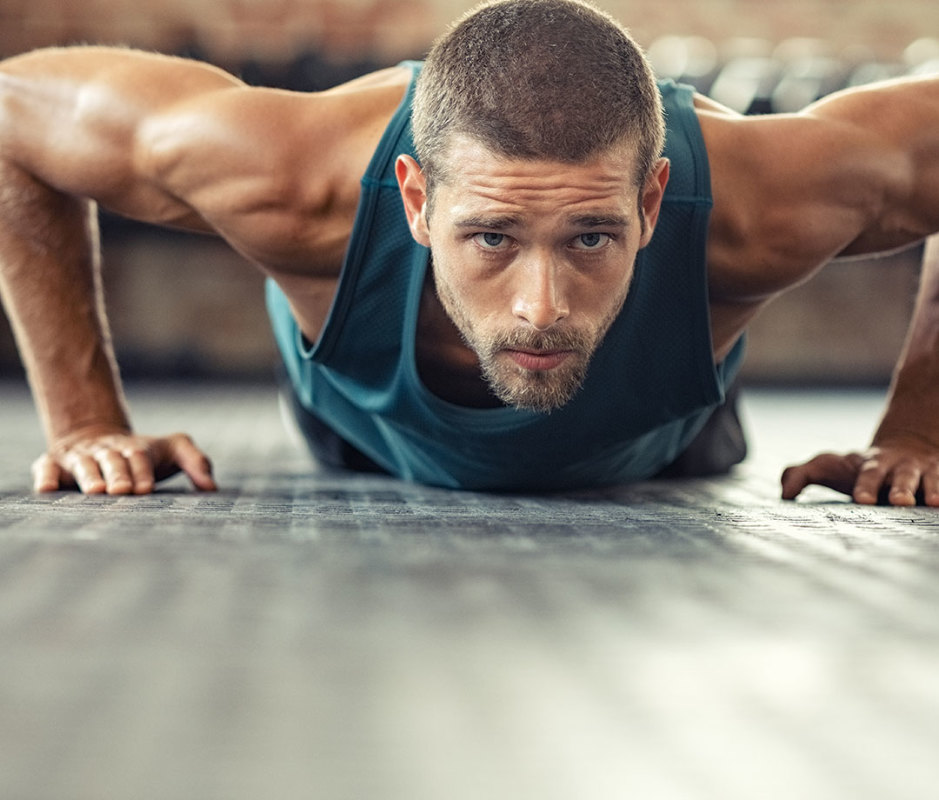
How to do it:
- Place a broom handle or dowel rod along your spine and keep it centered on your back as you perform traditional pushups. Not only does this force you to use proper form, but it also requires you to stay focused and engaged.
49. Landmine Standing Reach
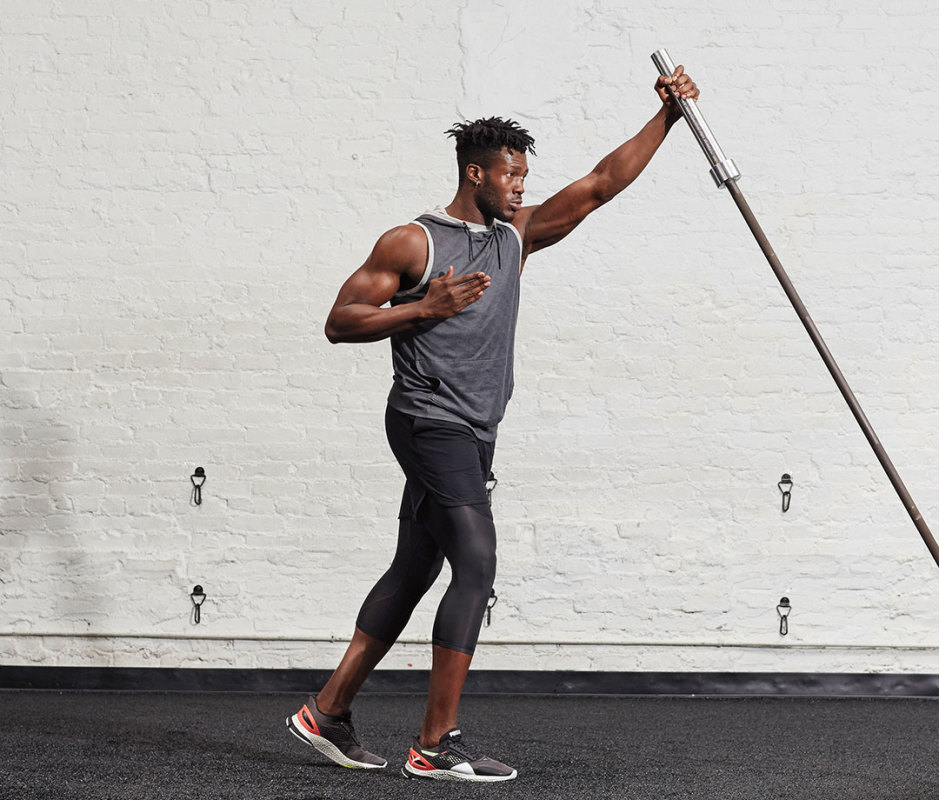
How to do it:
- Stand facing landmine, feet staggered slightly, right foot in front, landmine in left hand close to shoulder.
- Press left arm forward and overhead, and pull right elbow back, to start.
- In a swift motion, drop barbell to shoulder and thrust left hand up at a 45-degree angle, then quickly return to start for 1 rep. Do all reps on left side, then switch sides.
50. Incline Cable Flye to Chest Press
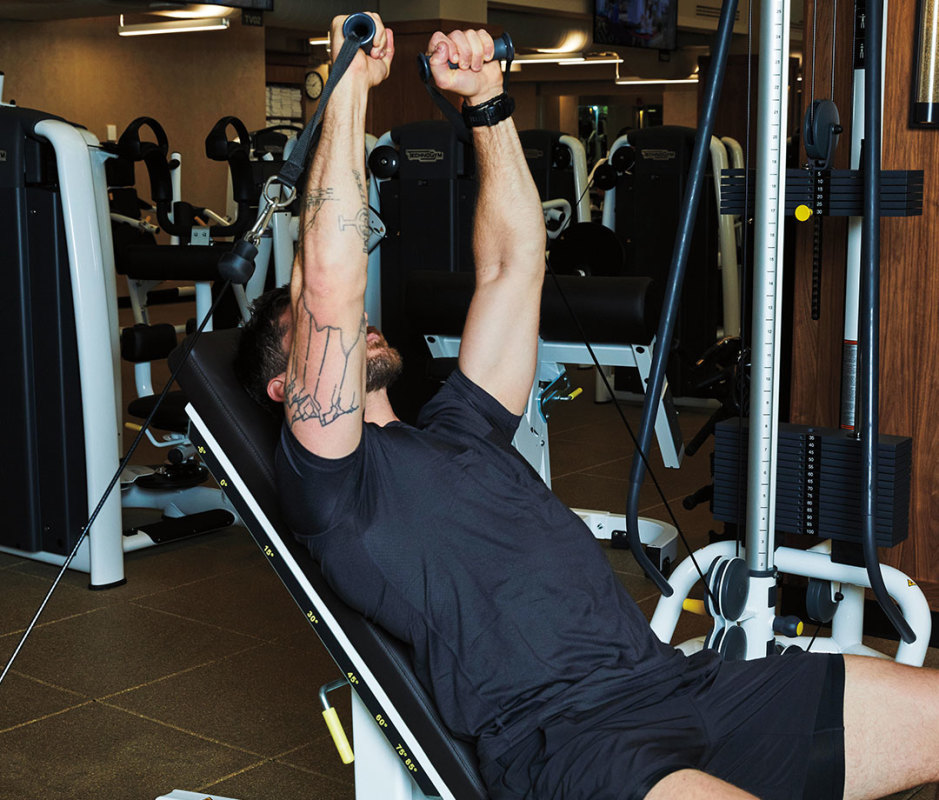
How to do it:
- Adjust a bench 45 degrees to the incline position in the middle of a cable machine with handle attachments to the lowest setting on either side.
- Grasp handles, then sit with arms extended, slight bend in elbows, palms facing each other. Contract pecs to bring hands together. Squeeze at the top, then slowly lower.
- Perform prescribed reps then change hand position to a wide incline cable chest press.
The Best Practices for Doing Chest Exercises
- Prioritize compound movements.
- Use progressive resistance (increase the weight or number of reps you perform each workout).
- Improve your shoulder stability to safeguard against injury (use “pulling” exercises that retract your shoulder blades).
Common Training Mistakes to Avoid
- Doing too many exercises in one workout.
- Going too heavy too quickly.
- Using improper form and technique.
Health
The Hazards and Blessings of Being Male: Embracing the Seven Challenges For a Successful Life

Although there have been infinite varieties of life forms that have evolved on Earth in the last 4 billion years, two life forms that are our male and female ancestors evolved a billion years ago. Here’s how this first sexual experience occurred according to cosmologist Dr. Brian Swimme and historian Dr. Thomas Berry in their book, The Universe Story.
The first male organism—they call him Tristan—and the first female organism—they call her Iseult—began life in the ancient oceans. Swimme and Berry describe their chance encounter this way:
“They were cast into the marine adventure, with its traumas of starvation and of predation. Able to nourish themselves but no longer capable of dividing into daughter cells, such primal living beings made their way through life until an almost certain death ended their 3-billion-year lineage.
A slight, an ever so slight, chance existed that a Tristan cell would come upon a corresponding Iseult cell.They would brush against each other, a contact similar to so many trillions of other encounters in their oceanic adventure. But with this one, something new would awaken. Something unsuspected and powerful and intelligent, as if they had drunk a magical elixir, would enter the flow of electricity through each organism.
Suddenly the very chemistry of their cell membranes would begin to change. Interactions evoked by newly functioning segments of her DNA would restructure the molecular web of Iseult’s skin, so that an act she had never experienced or planned for would begin to take place—Tristan entering her cell wholly.”
Of course no humans were there to record this original encounter, but we all have origin stories and this one resonates with me. Dates are never exact and change as more information is gathered. Here are some additional dates I found important in The Universe Story timeline:
- 12 billion years ago, the universe begins.
- 4 billion years ago life first emerges.
- 1 billion years ago sexual reproduction evolves.
- 216 million years ago the first mammals appear.
- 30 million years ago the first apes inhabit the earth.
- 2.6 million years ago the first humans appeared.
- 200,000 years ago Archaic Homo sapiens evolved.
- 10,600 years ago first settlements in the Middle East emerged and wheat and barley were cultivated.
Needless to say, we have a long evolutionary history to embrace. In their book, Solving Modern Problems with a Stone-Age Brain, Douglas T. Kenrick, PhD and David E. Lundberg-Kenrick describe seven evolutionary challenges we must all face and embrace. They offer a visual summary as a revision of Maslow’s original Hierarchy of Human Needs which they call The New Pyramid of Human Motives:

The Seven Challenges for a Successful Life
During the billion years of life, all organisms must embrace these challenges and they are particularly relevant beginning with our mammalian history. In their book, the Kenricks ask, “What are the fundamental problems of human existence?” They go on to share the results of their research.
“Together with a large team of researchers at more than 30 universities on five continents, we have been investigating the universal motivations faced by human beings around the globe.”
Here is a summary of their findings:
We must meet our basic physiological needs for shelter from the elements,
water, and food.
- Protect yourself from attackers and plunderers.
Given the scarcity of resources and the ever-present possibility of starvation, there has always been competition among different groups (most often the male members) for precious real estate and resources (including access to females).
As the Kenricks remind us. “Our ancestors were not rugged individualists.
They need to band together not only to protect themselves from bands of
marauding bad guys but also to accomplish most of the tasks of everyday life.”
Some people have always been more resourceful and clever than others and
some were more willing to bravely defend their groups against armed marauders.
Those resourceful and courageous individuals won higher status and gained
greater respect.
“From the perspective of evolution by natural selection,” say the Kenricks, “this
step is essential. Every one of our ancestors managed to attract at least one
person who wanted to make with them. Not everybody in the ancient world got
to reproduce, though, and a reasonable percentage of men went unmated.” This
fact, is of major importance when understanding male desires, fears, and
behavior.
From an evolutionary perspective, we not only have to find a mate who will have
sex with us, but we need to hold on to our mate long enough to have a child and
raise the child to maturity, so they can find a mate and continue the process.
- Care for your family members.
Unlike other animals, human males are much more involved with raising children, since human children require long-term care before they reach reproductive age.
Males and Females Are Alike and Also Different
Males and females are alike in that they must both successfully meet the seven challenges noted above. However, there are also significant evolutionary differences. These differences first came home to me when I first met psychologist David M. Buss and read his book, The Evolution of Desire: Strategies of Human Mating.
“If mating desires and other features of human psychology are products of our evolutionary history,” says Dr. Buss, “they should be found universally, not just in the United States.”
To test his theories, he conducted a five-year study working with collaborators from thirty-seven cultures located on six continents and five islands. All major racial groups, religious groups, and ethnic groups were represented. In all, his research team surveyed 10,047 persons world-wide.
Dr. Buss concluded that there are actually two human natures, one male, the other female. What do women really want? Buss found that the top three qualities that women look for in men are exactly the same as those things that men look for in women: Intelligence, kindness, and love. Then, what women want diverges from what men want.
“Women then look at a man’s ability to protect her and her children, his capacity to provide, and his willingness to make commitment to a relationship,” says Buss.
What do men really want?
“A man is drawn to youth and beauty,”
says Buss.
“This interest is not just a modern desire driven by advertising and male desire to control women [though advertisers take advantage of our evolutionary-driven desires]. It is a universal desire based on evolutionary pressures for reproductive success. Men who mated with women who were incapable of bearing children left no ancestors. Every man alive today is descended from men who did not make that mistake. Worldwide, men are drawn to younger women.”
Note: Just because we have these evolutionary-based desires does not mean we must act on them, that they are good for us, or will make us, or the partners we desire, happy. It also does not mean they are hard-wired into our biological makeup and can’t be changed. It does mean that we must take seriously our evolutionary-based desires and listen to the ancient “whisperings within” that pull us in certain directions.
The Hazards and Blessings of Gender-Specific Health
The ancient Roman philosopher, Virgil offers a simple truth to consider.
“The greatest wealth is health.”
A modern American medical doctor, Marianne J. Legato, M.D., world-renowned cardiologist and founder of The Foundation For Gender-Specific Medicine, says,
“The premature death of men is the most important—and neglected—health issue of our time.”
Although human males, as a group, occupy more positions of power in government and business than women, it has come at a price. This was first brought home to me by psychologist Herb Goldberg, in his book 1976, The Hazards of Being Male.
“The male has paid a heavy price for his masculine ‘privilege’ and power. He is out of touch with his emotions and his body. He is playing by the rules of the male game plan and with lemming-like purpose he is destroying himself—emotionally, psychologically and physically.”
In recent years we have learned a lot more about the realities of being male.
“If it’s true that men rule the world, it comes at a heavy cost,”
says Dr. Legato.
“From conception until death, men are inherently more fragile and vulnerable than women. In virtually every society today, men die first.”
Dr. Legato offers the following facts of life:
- The male fetus is less likely to survive the womb than the female.
- Boys are six weeks behind in developmental maturity at birth compared to girls.
- Men have four times the developmental disabilities of females.
- Men suffer more severely than women from seven of the ten most common infections that human experience [Including Covid-19].
- Men are likely to experience the first ravages of coronary artery disease in their mid-thirties, a full 15 or 20 years before women.
- Twice as many men die of heart disease, the leading cause of all deaths, than do women.
- Men die by suicide 4 times more than women.
- Murder and homicide are among the top four killers of men from the time they are born until heart disease and cancers begin to claim those who survive into middle age.
Accepting the realities of our own inherent weakness and vulnerabilities instead of trying to pretend we are masters of the universe is the first step we just take to begin our own healing and recovery.
I have been writing a series of articles on the Future of Men’s Mental Health. In Part 3, “Gender-Specific Healing and Man Therapy,” I explore my own healing journey and issues that address the unique problems faced by men and how the emerging field of Gender-Specific Healing and Men’s Health is a key to the future of health care. If you’d like more information about upcoming trainings, drop me an email to Jed@MenAlive.com and put “Gender-Specific Health Training” in the subject line.
Health
Healthy No-Bake Peanut Butter Bliss Balls

This post may contain affiliate links. As an Amazon Associate, I earn from qualifying purchases. Please read my disclosure.
My no-bake, healthy peanut butter bliss balls are loaded with creamy peanut butter and chocolate flavor, making them a hit with both kids and adults alike. Enjoy these as an on-the-go breakfast, wholesome snack, or healthy dessert alternative! They’re also dairy-free, vegan, gluten-free, and low in sugar, making them ideal for a variety of dietary preferences.
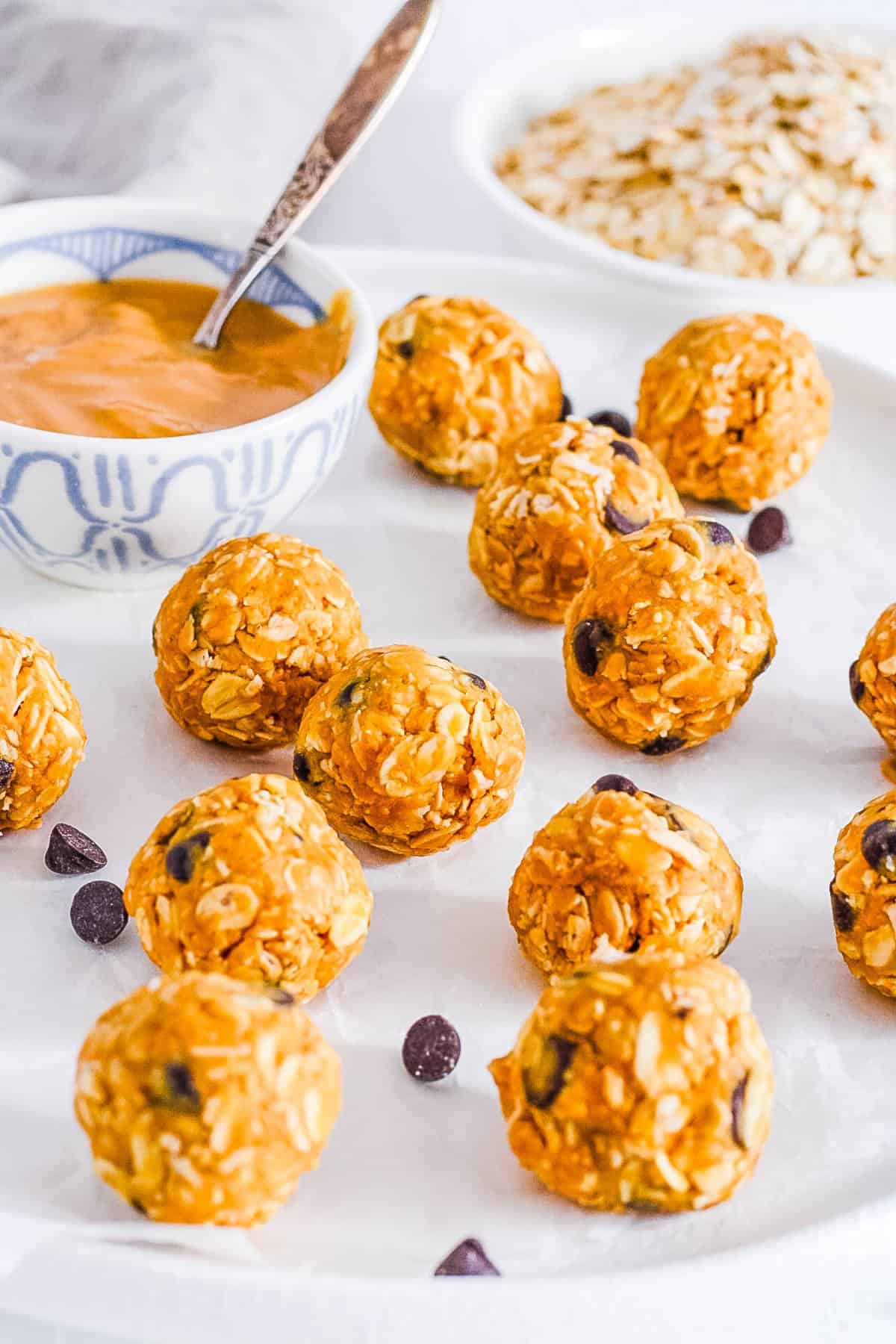
Indulge in my delicious no-bake peanut butter bliss balls, affectionately called “cookie dough bites” by my daughter. They taste like dessert, but are totally guilt-free and nutrient-rich! I love bliss ball recipes like this one because they come together quickly, and always satisfy my sweet tooth!
With only five simple ingredients and just ten minutes of prep time, bliss balls are a perfect option for busy days. I especially love making a huge batch at the beginning of the week, and enjoying them all week long for ultimate convenience. I find that they taste even better the next day, once they’ve had time to chill in the fridge for a while longer!
These protein balls with peanut butter are such a fun treat for any time of day! I really love how versatile they are – I’ll often use them as part of a quick breakfast, for packing in my kids’ lunches, or as a mid-afternoon snack.
Made with natural peanut butter, hearty oats, and a touch of pure maple syrup, I’ve crafted these bliss balls to be as healthy as possible. You won’t find any refined sugar here, even with these healthy swaps they still taste just like cookie dough. And each ball has only 90 calories and 3 grams of sugar!
I’ve also made sure that these wholesome ingredients can come together with minimal equipment required. No need to deal with your bulky food processor and spend all that extra time cleaning!
And my all time favorite thing about this recipe is that it’s a great way to involve kids in the kitchen. My kids have so much fun helping me out and adding in their own special twists.
Your family can also customize them in so many different ways, changing things up based on your preferences! I’ll share my favorite variations later in this post (like my peanut butter bliss balls with protein powder)!
Latest Recipe Video!
🥘 Ingredients
My easy peanut butter bliss balls recipe calls for just 5 nutritious ingredients, all easily found in your pantry or local grocery store. Here’s what you need:
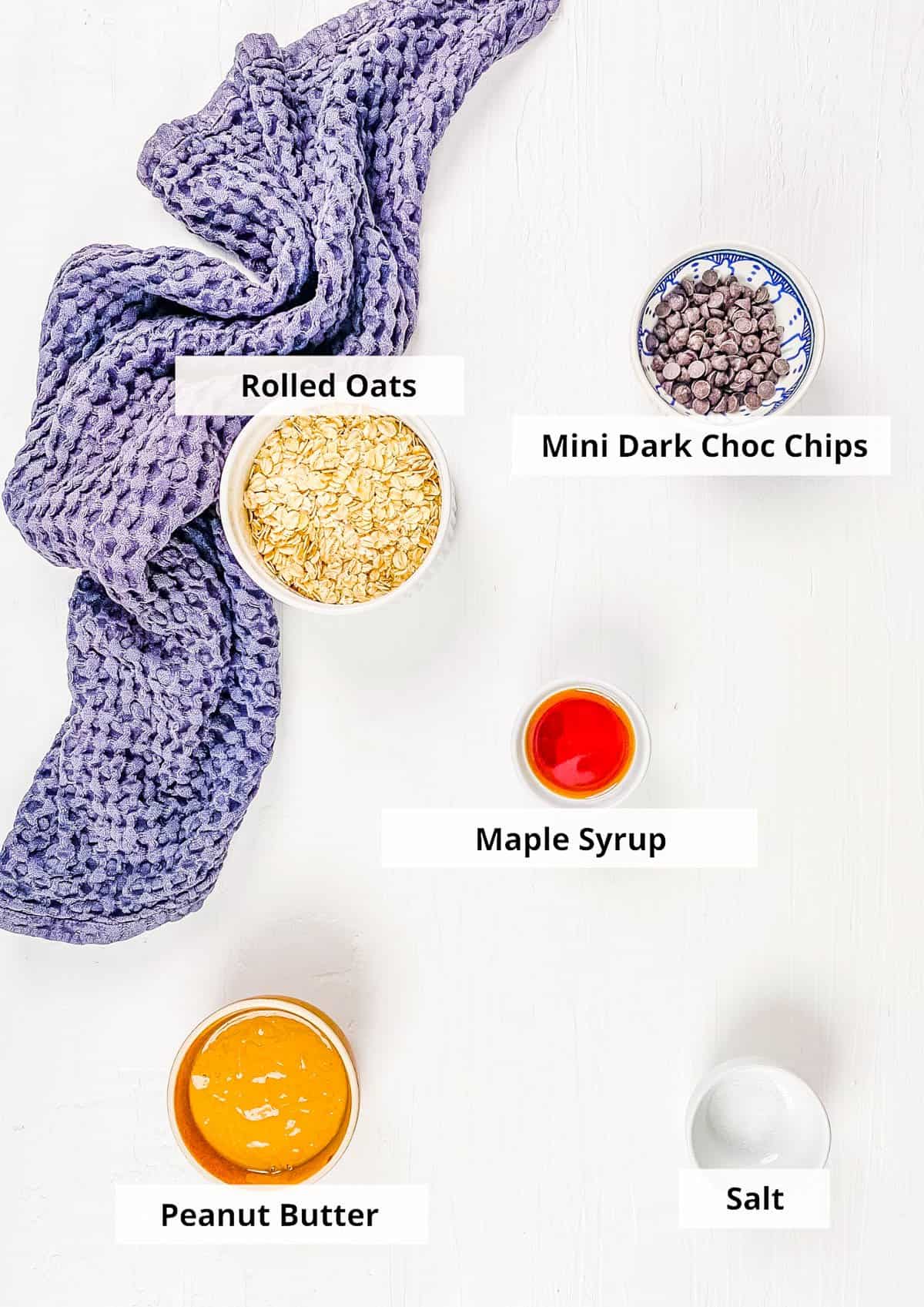
Oats: I’ve found that rolled oats work best for these kid-friendly bliss balls. I don’t recommend using oat flour or quick oats as it won’t have the same texture as whole oats, and won’t hold up as well.
Natural Peanut Butter: I use creamy peanut butter to bind all the ingredients together and add a boost of protein to these energy bites. If you don’t have peanut butter, try almond butter as a 1:1 substitute. Other nut butters (like cashew butter or a mixed nut butter) should also work in place of peanut butter, but the bites might have a slightly different consistency since some nuts create a thinner or runnier butter than others!
Dark Chocolate Chips: I prefer using dark chocolate chips for a healthier choice. These can be regular or mini chocolate chips. To keep this recipe vegan-friendly, I’ll use dairy-free chocolate chips. If you don’t need these to be vegan, then semisweet, white chocolate, or milk chocolate chips are all yummy options.
Maple Syrup: The only added sugar is natural maple syrup which gives the bliss balls a slightly sweet taste. If you don’t have maple syrup on hand, agave, raw honey, or vegan honey work.
Vanilla Extract: Pure vanilla extract brings out the richness of the chocolate. Sometimes I also add a pinch of salt to really enhance the sweetness. For a nutty flavor, try using almond extract.
🔪 How To Make Peanut Butter Bliss Balls
My vegan no bake peanut butter balls are so easy to make – they’re ready in just 3 simple steps. Let me show you how to make these healthy dessert balls:
Combine Ingredients: In a large bowl, using a wooden spoon, I start by stirring together the oats, peanut butter, chocolate chips, maple syrup, vanilla, and salt until combined.
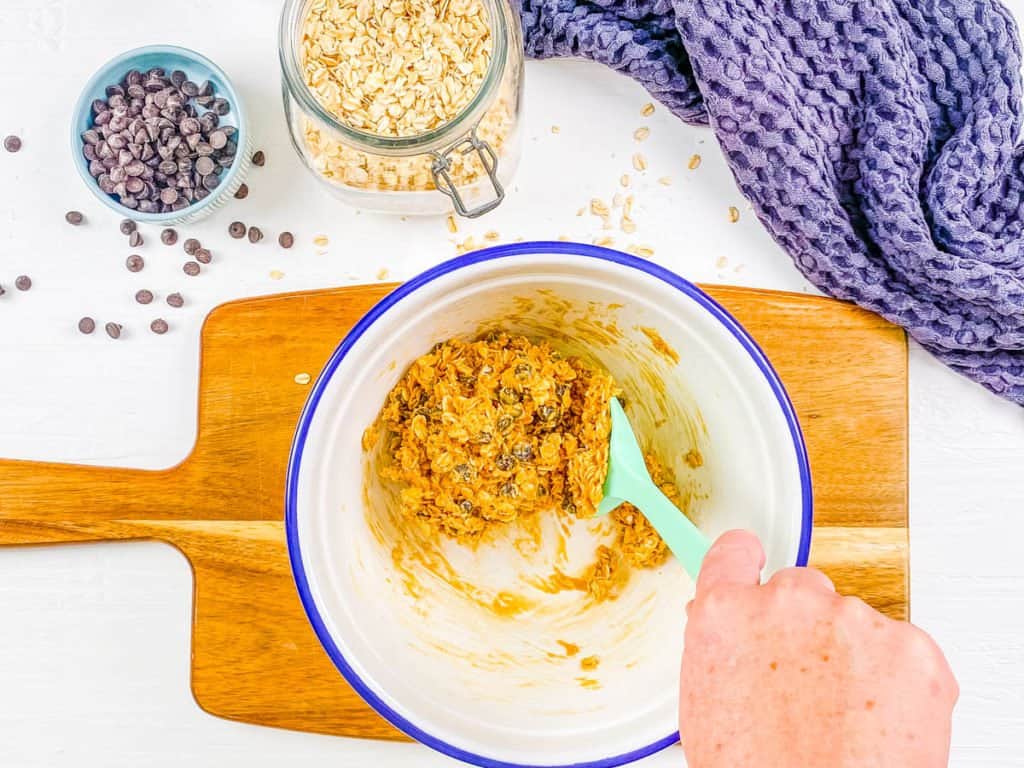
Form The Bliss Balls: Next, I line a baking sheet with parchment paper. Taking small handfuls of the mixture, I roll them into small balls 1-2 inches in size – about the size of a golf ball or ping pong ball. I prefer to use a cookie scoop to make this step extra easy. Place each ball onto the baking sheet.
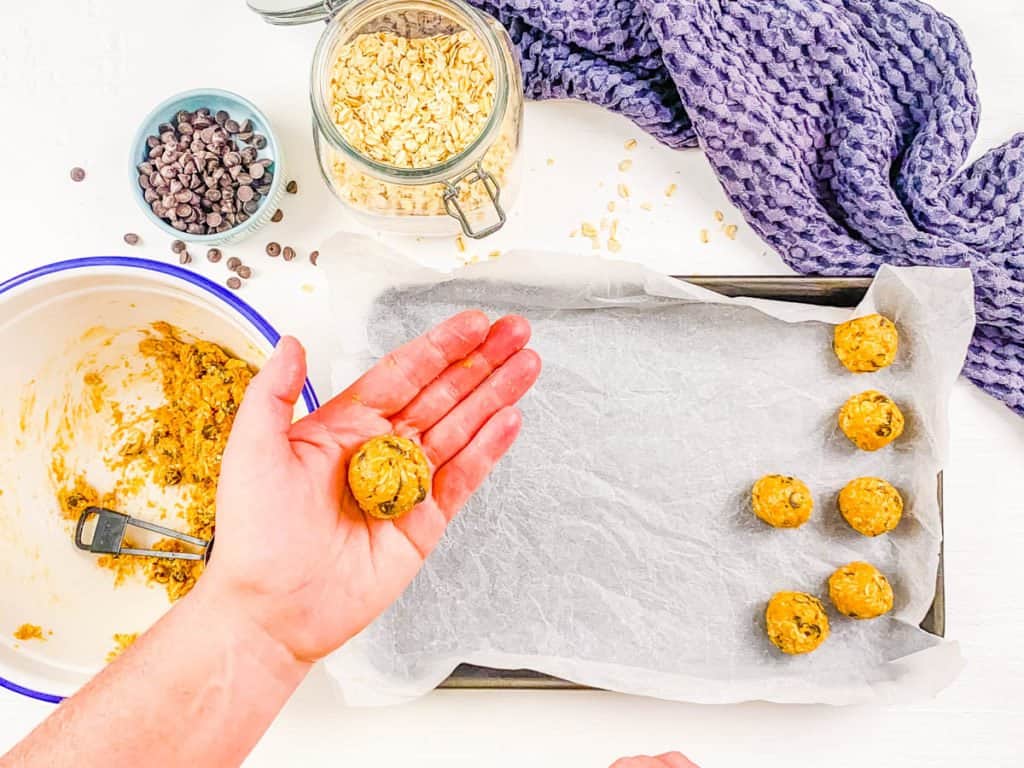
Let The Balls Set: Once rolled, I refrigerate these peanut butter snack balls for 30 minutes or until solid.
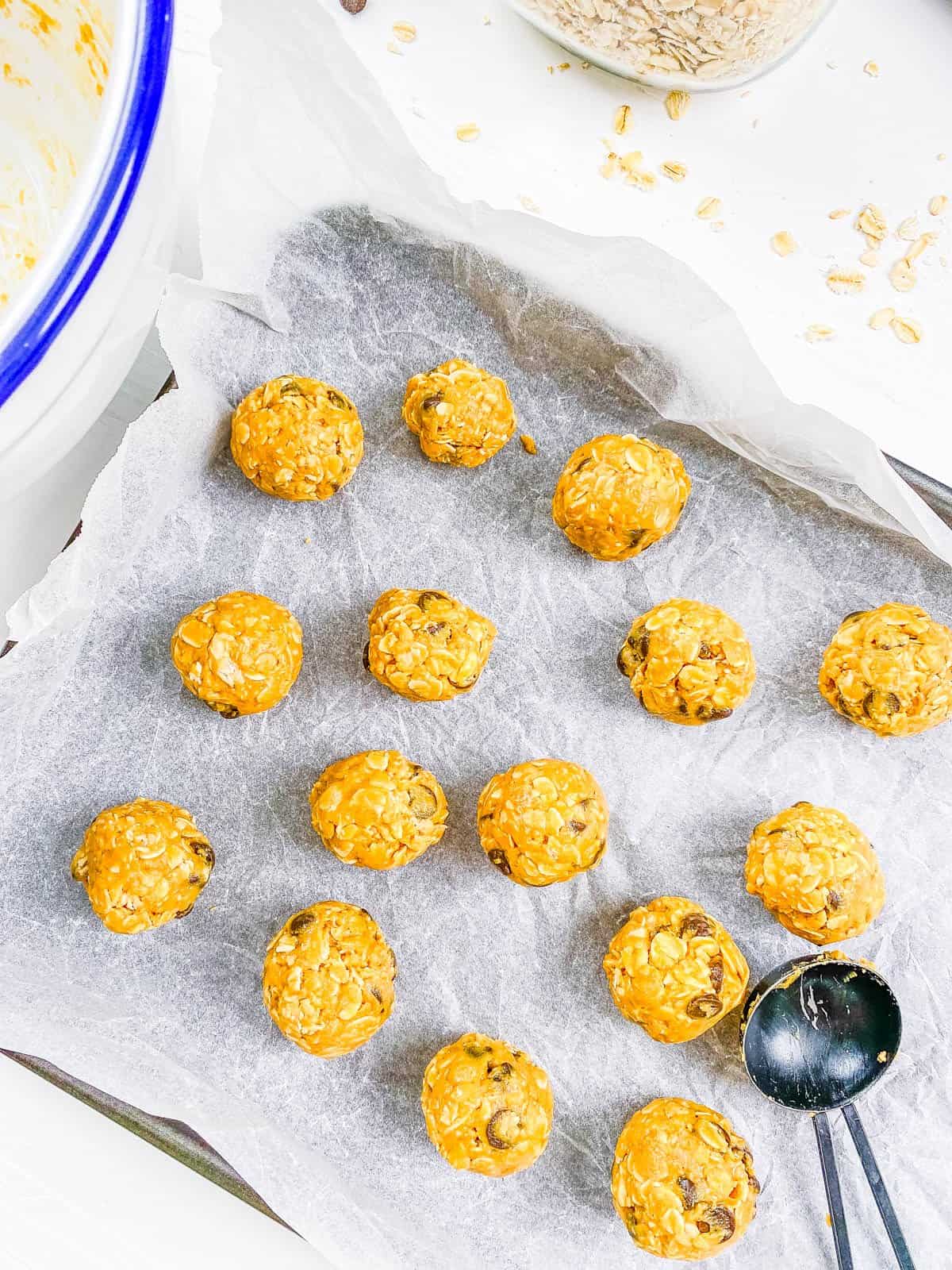
My #1 Secret Tip for this recipe is to make sure you measure ingredients precisely, with the right ratio of wet to dry ingredients.
While there is a little wiggle room with these bliss balls due to them being a no-bake recipe, I recommend being precise with all measurements to ensure ensures that the mixture has the right consistency to hold together without being too sticky or crumbly.
The creamy peanut butter is critical as the binding ingredient for these bliss balls, and I find it to be especially important to measure correctly. Too much or too little will throw the whole recipe off, leading to a mixture that is either too wet and sticky or too dry and crumbly.
After trial and error, I have found that achieving this balance is important for forming perfect bliss balls that stay intact and have a great texture.
Other Tips To Keep In Mind:
- Use The Right Tools: I like to use a cookie scoop to get all of these no-bake bliss balls the same size and to help my hands stay mess free!
- Check The Oats: If you or someone in your family is gluten intolerant, be sure to check the packaging on your oats for gluten-free certification. Some oats can be at risk for contamination with gluten substances.
- Involve The Kiddos: My kids love to help out in the kitchen, and this no-bake recipe is perfect for kids of all ages! They can learn how to measure out ingredients, combine ingredients, and roll the mixture into perfect ball shapes!
- Adjust For Moisture: If the dough seems too wet to mold into balls, consider adding a tablespoon or two of oat flour or almond flour. This will help to firm the mixture up so that it holds its shape and doesn’t stick to your hands.
- Bliss Balls For Kids: If you want to make these as toddler peanut butter balls I recommend reducing or omitting the sugar! You might also want to cut them into smaller bites when serving.
📖 Variations
I’ve perfected a few easy swaps and add-ins for when I’m looking to switch up the taste or texture a bit with these healthy kid-friendly bliss balls. There is something for any occasion! Here are my favorite variations:
Peanut Butter Protein Balls: If you want to turn these peanut butter protein bliss balls, consider adding a scoop of vegan vanilla protein powder to the batter before mixing it. You can use up to 2 scoops of protein powder, depending on the flavor of the protein powder you use. Sometimes I also add 1 tablespoon of ground chia seeds, flax seed, or hemp seeds for an extra boost of protein and healthy fats.
Chocolate Bliss Balls With Peanut Butter: For a double serving of chocolate, add a tablespoon of cacao or cocoa powder to the batter before mixing. I love the rich and indulgent flavor that this gives this recipe! I serve this as a healthy kids dessert often!
Peanut Butter Date Bliss Balls: For a sweeter flavor, I like to add a ¼ cup of Medjool dates, soaked and drained. I use a food processor when adding dates so that they are completely incorporated with the peanut butter and oats.
Sugar-Free Bliss Balls: If you want to make these no-bake peanut butter balls truly sugar-free, you can omit the maple syrup and use sugar-free chocolate. I think they still taste pretty good thanks to the natural sweetness from the vanilla and chocolate chips! If you are making these peanut butter balls for toddlers, this is a good option.
Mix-Ins: Add your favorite mix-ins to give these peanut butter energy balls some texture. I find that crushed walnuts, pecans, peanuts, sunflower seeds, and cacao nibs work really well in this recipe. My other favorites are dried fruit like cranberries, raisins, dried apricots, and shredded coconut. I also love adding spices like a pinch of sea salt, cinnamon powder, nutmeg, or pumpkin pie spice into the mixture. When making these as toddler protein balls, be mindful of the size of the nuts and dried fruit.
🍽 Serving Suggestions
While I love these healthy bliss balls with peanut butter on their own for an easy grab-and-go snack or healthy dessert, it can be so fun to get creative with other ways to serve these! Try some of these ideas:
Toppings: For a decadent dessert I love to drizzle chocolate sauce or caramel sauce (like the one on this no-bake salted caramel cheesecake) over these no bake snacks!
Ice Cream: My kids love to mix these no bake peanut butter dessert balls into tofu ice cream for a delicious treat.
Drinks: Energy balls can be found at a lot of coffee shops nowadays, so it only feels right to create those coffee shop vibes at home! I have been loving these balls with my oatmilk honey latte or iced ube latte! You can also do a creamy mixed berry smoothie alongside these protein balls for kids as an afternoon snack.
With Other Energy Bites: Make a spread of energy bites and serve these alongside my vegan protein balls, peanut butter date balls, and these homemade lara bars! I love this idea for parties and special occasions!
🫙 Storage Instructions
Room Temperature: I store these dairy free peanut butter balls in an airtight container at room temperature for up to 3 days.
To Refrigerate: After placing in an airtight container or resealable plastic bag, I’ll store these in the fridge for maximum freshness. They’ll be good for about one week!
Freezer: I don’t recommend storing these vegan energy balls in the freezer as they won’t taste as good when defrosted.
❓Recipe FAQs
The best type of peanut butter to use is natural peanut butter with no added sugars, oils, or preservatives. I recommend looking for a brand that has just one ingredient listed: peanuts. You can also use a brand that has peanuts and salt listed as the only two ingredients.
There are two ways I’d recommend adjusting this recipe if your mixture is too dry: 1) Add more peanut butter – it’ll help bind the ingredients and add moisture. 2) Add a little bit of coconut oil, maple syrup, or even a touch of applesauce – these ingredients will add moisture and flavor to your peanut butter oat balls!
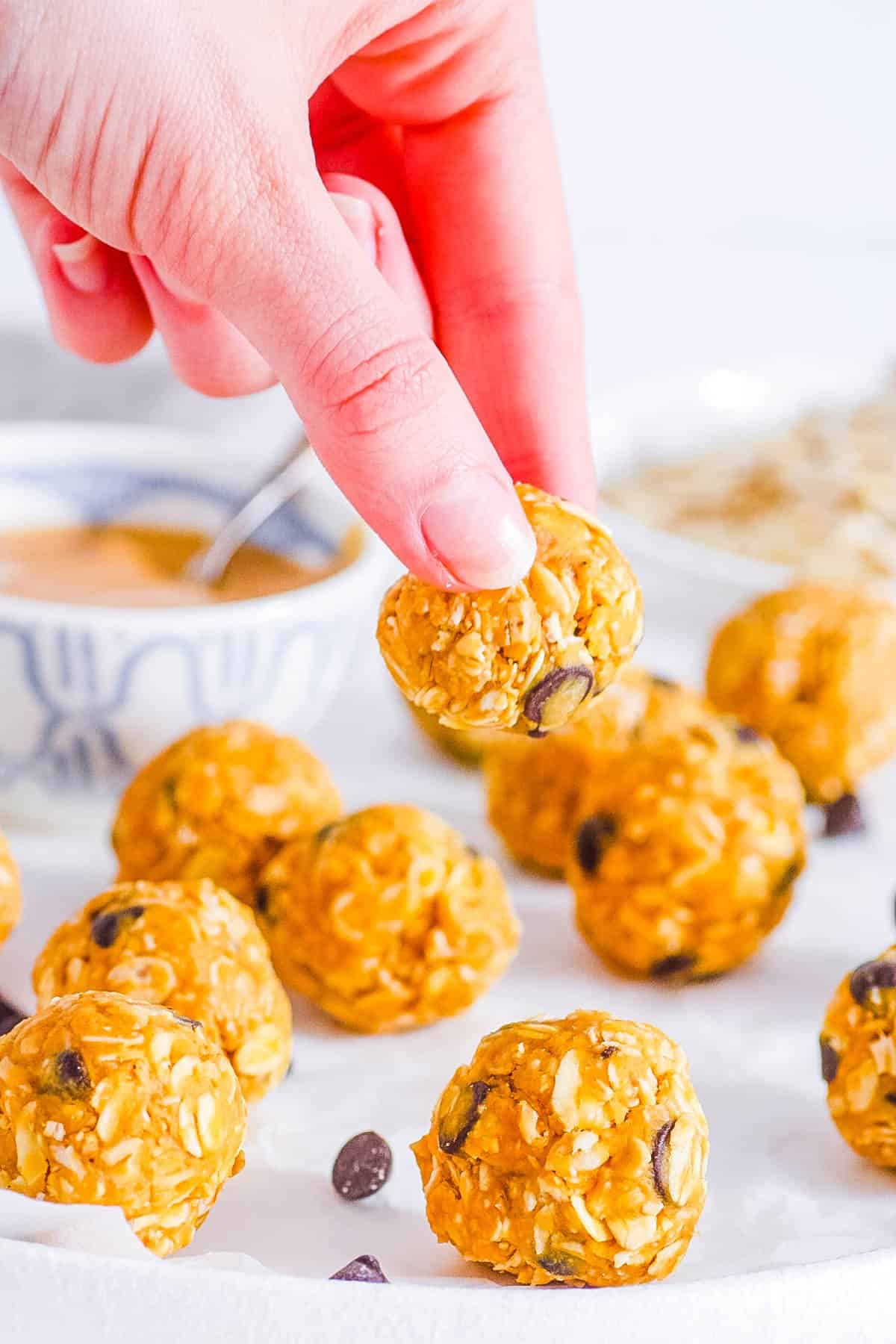
Want to Save This Recipe?
Enter your email & I’ll send it to your inbox. Plus, get great new recipes from me every week!
By submitting this form, you consent to receive emails from The Picky Eater.
Love this plant based dessert recipe? Please leave a 5-star rating 🌟 in the recipe below and/or a review in the comments section further down the page!
You can also FOLLOW ME on FACEBOOK, INSTAGRAM, and PINTEREST to see more delicious, healthy, family-friendly food, and if you have any questions, I’m here to help!
📋 Recipe Card
Healthy No-Bake Peanut Butter Bliss Balls
My healthy, easy no bake peanut butter bliss balls are loaded with creamy peanut butter and chocolate flavor, making them a hit with both kids and adults alike. Enjoy these as an on-the-go breakfast, wholesome snack, or healthy dessert alternative! They’re also dairy-free, vegan, gluten-free, and low in sugar, making them ideal for a variety of dietary preferences.
Servings: 16 balls
Calories: 93kcal
-
In a large bowl, using a wooden spoon, stir together the oats, peanut butter, chocolate chips, maple syrup, vanilla, salt (and protein powder, if using) until combined.
-
Line a baking sheet with parchment paper.
-
Taking small handfuls of the mixture, roll them into small balls 1-2 inches in size. Or you can use a cookie scoop. Place them onto the baking sheet.
-
Refrigerate the bites for 30 minutes or until solid. Store in an air-tight container in the fridge (they will last at least 1 week, and likely 2!)
- Use The Right Tools: Use a cookie scoop to get all of the balls the same size.
- Check The Oats: If you or someone in your family is gluten intolerant, be sure to use gluten-free oats.
- Involve The Kiddos: This is such a great no bake recipe for kids to make – get them in the kitchen!
- Adjust For Moisture: If the dough seems too wet to mold into balls, consider adding a tablespoon or two of almond flour.
- Sugar Free: If you want to make these truly sugar-free, you can omit the maple syrup, and they will still taste pretty good.
- Peanut-Free: Use your favorite alternative nut butter or seed-based butter.
- Nutritional information includes protein powder. Note: for even more protein, use 1 scoop of vegan vanilla protein powder and 1 scoop of peanut butter protein powder.
Serving: 1ball | Calories: 93kcal | Carbohydrates: 8g | Protein: 4g | Fat: 5g | Saturated Fat: 2g | Polyunsaturated Fat: 1g | Monounsaturated Fat: 2g | Cholesterol: 4mg | Sodium: 43mg | Potassium: 92mg | Fiber: 1g | Sugar: 3g
Health
Federal Experts Talk Bird Flu ‘What Ifs’ in WebMD Live Event

May 16, 2024 – Multiple U.S. agencies are working to contain the recent bird flu outbreak among cattle to prevent further spread to humans (beyond one case reported in early April) and use what we learned before, during, and after the COVID-19 pandemic to keep farm workers and the general public safe.
Fingers crossed, the bird flu will be contained and peter out. Or the outbreak could continue to spread among dairy cattle and other animals, threatening the health and livelihoods of farmers and others who work with livestock.
Or the virus could change in a way that makes it easier to infect and spread among people. If this happens, the worst-case scenario could be a new influenza pandemic.
With so many unknowns, WebMD brought together experts from four federal agencies to talk prevention, monitoring, and what the “what ifs” of bird flu might look like.
Communication with the public “about what we know, what we don’t know, and ways you and your family can stay safe is a priority for us at CDC,” said Nirav D. Shah, MD, JD, the CDC’s principal deputy director. “We at the federal level are responding, and we want the public to be following along.”
People should consult the websites for the CDC, FDA, U.S. Department of Agriculture (USDA), and the Administration for Strategic Preparedness and Response (ASPR) for updates.
It is essential to not only stay informed, but to seek trusted sources of information, Shah said during “Bird Flu 2024 – What You Need to Know,” an online briefing jointly sponsored by the CDC and WebMD.
An ‘Experimental Hamburger’
If one take-home message emerged from the event, it was that the threat to the general public remains low.
The retail milk supply is safe, although consuming raw or unpasteurized milk is not recommended. “While commercial milk supply is safe, we strongly advise against drinking raw milk,” said Donald A. Prater, DVM, acting director for the FDA’s Center for Food Safety and Applied Nutrition.
As for other foods, thoroughly cooked eggs are less risky than raw eggs, and the nation’s beef supply remains free of the virus as well.
For years, federal inspectors have purchased and tested meat at retail stores, said Eric Deeble, DVM, USDA deputy assistant secretary for the Office of Congressional Relations. So far, H5N1, the virus behind bird flu, has not been detected in beef.
The USDA took testing a step further and recently cooked ground beef from dairy cows in their lab. Using what Deeble described as an “experimental hamburger,” the agency showed cooking beef to 165 F or higher kills the virus if it ever becomes necessary.
The federal government now requires all cattle be tested and be free of bird flu virus before crossing any state lines. The government is also reimbursing farmers for veterinary care and loss of business related to the outbreak, and supply personal protective equipment (PPE) like gloves, masks, and face shields to workers.
Vaccination Not Recommended Now
Federal scientists know enough about H5N1 virus to create vaccines against it quickly if the need arises. It’s more about planning ahead at this point. “Vaccines are not part of our response right now,” said David Boucher, PhD, director of infectious diseases preparedness and response at the Administration for Strategic Preparedness and Response.
If the virus changes and becomes a bigger threat to people, “we have the building blocks to produce a vaccine,” Boucher added.
An event attendee asked if the seasonal flu shot offers any protection. “Unfortunately, the flu shot you got last year does not provide great protection from the avian flu,” Shah responded. “It might do a little bit … but that is the vaccine for seasonal flu. This is something more novel.”
Treatments Stockpiled and Ready
Antiviral medications, which if given early in the course of bird flu infection could shorten the severity or duration of illness, are available now, Shah said. The dairy farmer who was infected with bird flu earlier this year responded to oseltamivir (Tamiflu) treatment, for example.
When it comes to bird flu symptoms, the fact that the only infected person reported so far this year developed pink eye, also known as conjunctivitis, is interesting, Shah said. Officials would have expected to see more typical seasonal flu symptoms, he added.
“Influenza is not a new virus,” Boucher said. “With this strain of influenza, we are not seeing any genetic markers associated with resistance to antivirals. That means the antivirals we take for seasonal influenza would also be available if needed to treat H5N1.”
ASPR has stockpiled Tamiflu and three other antivirals. “We do have tens of millions of courses that can be distributed around the country if we need them,” he added.
“Influenza is an enemy we know well,” Boucher said. That is why “we have antivirals ready to go now and many types of PPE.”
Science in Action
The feds intend to stay on the case. They will continue to monitor emergency department visits, lab test orders, and wastewater samples for any changes suggesting a human pandemic risk is growing.
“While we’ve learned a great deal, there are still many things we do not know,” Deeble said.
Shah added, “As in any outbreak, this is an evolving situation and things can change. What you are seeing now is science in action.”
For the latest updates on bird flu in the United States, visit the CDC’s H5N1 Bird Flu: Current Situation Summary website.
-

 African History4 months ago
African History4 months agoBlack History Facts I had to Learn on My Own pt.6 📜
-

 African History4 years ago
African History4 years agoA Closer Look: Afro-Mexicans 🇲🇽
-

 African History1 year ago
African History1 year agoPROOF AFRICAN AMERICANS AIN'T FROM AFRICA DOCUMENTED EVIDENCE
-

 African History2 years ago
African History2 years agoHow Did Normal Medieval People Survive Winter? | Tudor Monastery Farm | Chronicle
-

 African History4 years ago
African History4 years agoA Closer Look: Afro-Mexicans 🇲🇽
-

 African History3 years ago
African History3 years agoWhat happened to the many African Kingdoms? History of Africa 1500-1800 Documentary 1/6
-

 African History3 years ago
African History3 years agoThe Entire History of Africa in Under 10 Minutes – Documentary
-

 African History2 years ago
African History2 years agoAFRO MEXICO: Black History In Mexico!

























